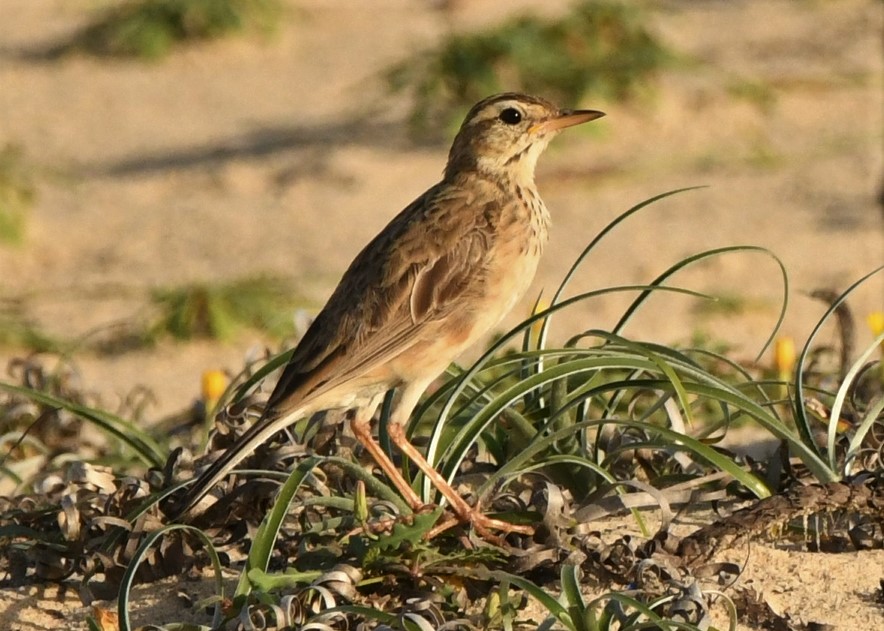
Recent Reports and Bird Lists:
Link to: Vietnam Coastal Bird Survey 2023 (Including Cam Ranh Bay)
Link to: Cam Ranh Bay Reports & Annotated Bird Lists, October & November 2022
Link to: Cam Ranh Bay Report & Annotated Bird List, January 2020
* Scroll down for Cam Ranh Bay Report and Annotated Bird List, July 2019
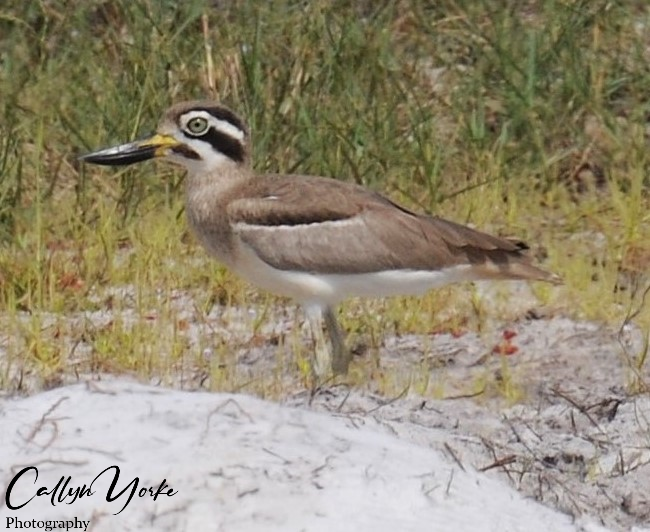
Cam Ranh, Khánh Hòa Province, Việt Nam: 1-5 March, 2024 (58 Species)
Callyn Yorke
Survey Dates, Times and Locations (scroll down to November 8-14 report for detailed area descriptions)
Weather: Mostly fair to partly cloudy; 23°C to 32°C ; winds ENE 2 -30 kph with highest velocities in the afternoon. Low-Tide @ 0600-0800 hrs.. Bay and seas with wind chop; surf 1-3 ft. at Bai Dai.
Time: Sunrise (0600 hrs.) to sunset (1750 hrs.); primarily morning and late afternoon, 2-3 hr. surveys.
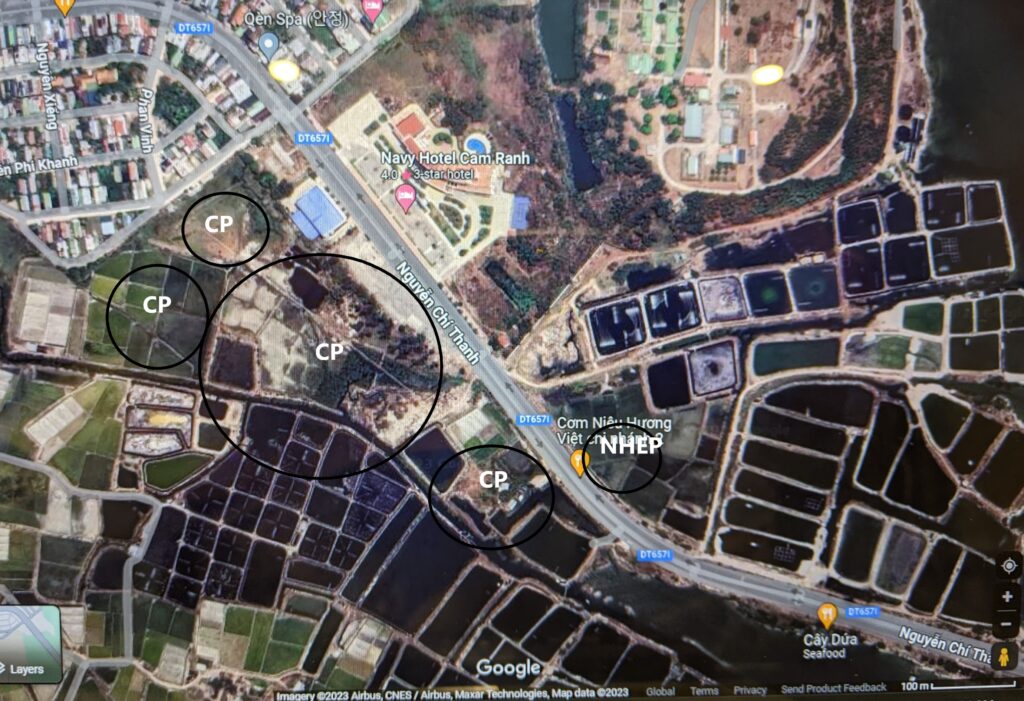
Casuarina Ponds Survey (CP): 2, 3 & 5 March 2024: 0820-0930 hrs.; 2-4 March 2024:1600-1750 hrs. Walk-through surveys of salt ponds (northeast section), abandoned aquaculture ponds (central & south), mangrove (east), pasture and coastal scrub was made. Bird nets present during the previous surveys in November, 2023 have been removed. Several of the south ponds remained dry to partially inundated during high tides; those sections often attracted the greatest number and diversity of shorebirds. Ponds in the southwest corner remained wet and/or fully inundated, independently of the tides. Comparatively high tides occurred during the afternoon of 4 & 5 March, 2024, inundating the mangrove and central pond areas. A small herd of cattle usually grazed the pasture during the surveys. Due to fencing, access for birding this area is now primarily in the northeast corner of the site adjacent to the salt ponds. Several dogs (non-aggressive) ran loose through the area during the surveys.
Navy Hotel grounds and suburban neighborhood (NH) and East Ponds Survey (EP): 1 March 2024: 1512-1545 hrs..; 2 March 2024: 0608-0800 hrs..; 3 & 5 March 2024: 0610- 0710 hrs.; Mostly stationary surveys were made while sitting on concrete steps of the roadway embankment, overlooking the abandoned aquaculture ponds and adjacent mangrove. The coastal scrub and plantings around the Navy Hotel were also surveyed while in transit to the ponds and other locations in the area. Low tides in the mornings left most of the ponds exposed as mudflats, which attracted the greatest number and variety of shorebirds. High tides in the afternoon fully inundated the ponds; few shorebirds were found at those times.
West Ponds and Marsh (Naval Base Property – Permission for Entry Required – WSPM): 3 March, 2024. 0645-0700 hrs.. From the coast highway (QL1a), I made a brief, visual survey of the western section, where waterbirds were concentrated in wetlands.
East Cam Rahn Bay DT 6571 Access Road (ECRB). 4 March, 2024: 064-0715 hrs. I walked the paved access road about 0.8 km northward from the junction of the Bai Dai coast highway (DT 6571) west of the CRB airport (see Annotated Satellite Map below). This coastal scrub area has been used for construction debris and as a general rubbish dump. The vegetation includes invasive Prickly-pear cactus (Opuntia sp.) and native Caltrope (Caltropis gigantea). A relatively dense stand of woody shrubs and small trees covers much of the low hills; soils are a mosaic of rocky alluvial deposits and coralline sand.
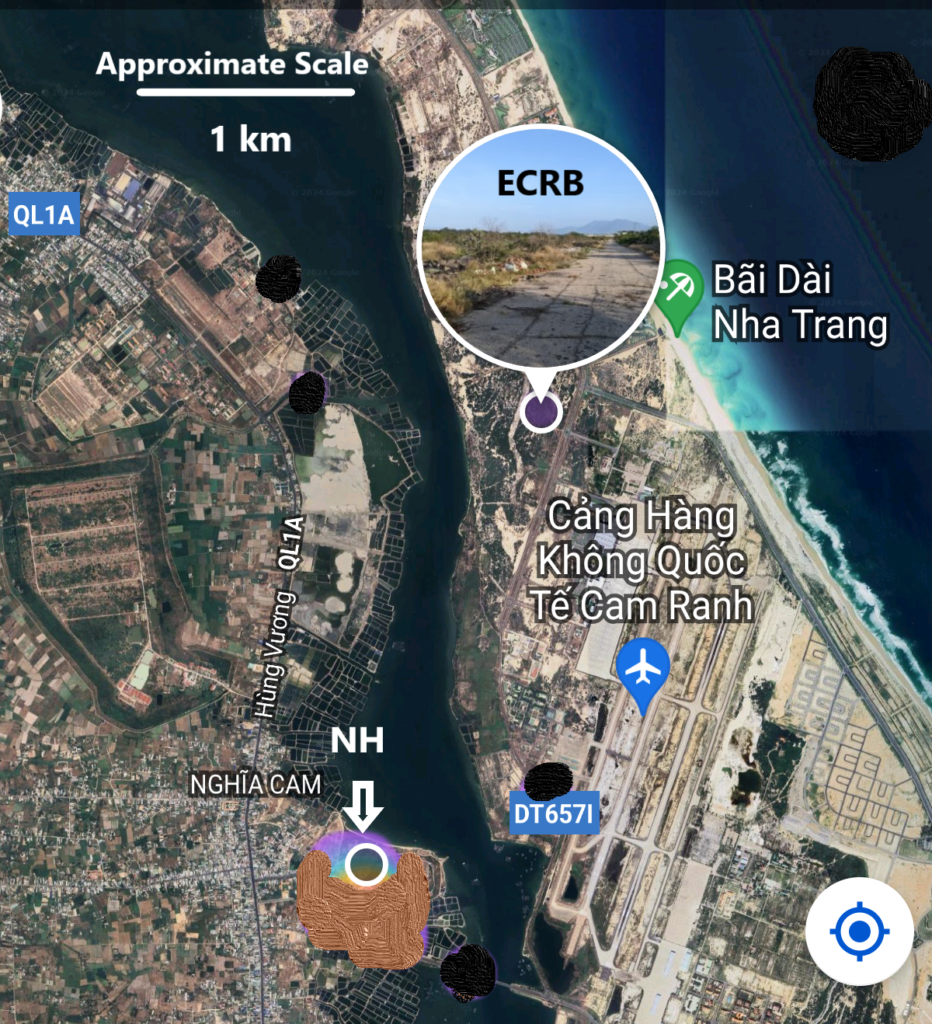
White Sands Hotel Area (WSH): 4 March, 2024: 0800-0840 hrs.. I walked through this area where I had found Great Thicknee during previous surveys (11 November, 2023; 14 January 2024). Multiple sets of fresh tracks in the sand belonging to GRTH were found during this survey; none of the owners of those tracks were seen. Workers with chainsaws were harvesting Acacia trees in this area (see Annotated Bird List).
Annotated Bird List – Cam Ranh Bay Area – March 1-5, 2024 Callyn Yorke
LEGEND
Abundance: Numbers following each species entry are the highest count for a single survey, when multiple surveys at a particular location were made. Locations (see below) with the highest numerical abundance are listed first in the species accounts.
Age, sex and molt (when known): ad = adult; imm = immature; m = male; f = female; bsc plmg = basic (non-breeding plumage; alt plmg = alternate (breeding) plumage; trans = transitional plumage, e.g. alternate into basic plumage.
Survey Location Abbreviations (see preceeding maps): NH = Navy Hotel grounds and adjacent suburbs; EP = East aquaculture ponds and mangrove adjacent to NH; CP = Casuarina Ponds, mangrove, coastal scrub, casuarinas and pasture; WSPM = Western Ponds and Marsh; ECRB = East Cam Ranh Bay “resort highway” (DT 6571) parallel access road; WSHA = White Sands Hotel Area (west of DT 6571 roundabout), including a large lotus lily lake and abandoned, water-filled sand-mining pits surrounded by exotic Acacia woodland (currently being logged) and native coastal scrub.
Ecology and Behavior: aerial insect hawking (ah); taking fruit, berries or parts of flowers (fr); gleaning insects from foliage (ig); probing into surface (pr); estimated height (m) above ground (agl); gregarious (greg); mixed-species flock (msf).
Systematics and Nomenclature used herein, is an amalgam of Avibase, International Ornithological Congress (IOC) and current (2024) online resources, i.e. Birds of the World, Cornell University, USA. Abbreviations for species’ common names follow the North American system, i.e. using the first four letters of the compound name, e.g. Great Thicknee (GRTH); Asian Green Bee-eater (AGBE), etc..
Note: Species of Special Concern, i.e. listed by IUCN as Near Threatened (NT); Vulnerable (VU); Endangered (EN); Critically Endangered (CR), are shown with bold-face type.
Birds Noted
- Chinese Swan Goose Anser cygnoides (domestic) 8 (ad., imm), greg. vocal; adults protective of young goslings, CP.
- Gray-lag Goose Anser anser (domestic leucistic) 1 at edge of neighborhood lily pond, NH.
- Mallard Anas platyrhynchos 1 (domestic leucistic) 1 vocal, swimming in same pond with GLGO, NH.
- Feral Rock Pigeon Columba livia 5 greg. in pasture and flying around neighborhood, CP; NH.
- Germain’s Swiftlet Aerodromus germani 120 (conserv. est.) greg. flying 1 – 80m agl over all habitats except open bay waters, ubiq..
- Greater Coucal Centropus sinensis 5 vocal, pairs active at edge of ponds in second-growth and coastal scrub, ubiq..
- Plaintive Cuckoo Cacomantis merulinus 1 repeatedly vocal in trees at edge of clearings and garden, NH.
- White-breasted Waterhen Amaurornis phoenicurus 2 individuals and pairs; shy and retiring; active at dawn and dusk in wet grass at edges of ponds, NH; EP.
- White-browed Crake Amaurornis cinerea 3 greg. individuals and pairs foraging at edges of lily ponds and pasture, NH; CP.
- Common Moorhen Gallinula chloropus 3 individuals swimming, partially concealed in lily lake, WSHA.
- Yellow Bittern Ixobrychus sinensis 2 concealed individuals readily flushed from mangrove; sedentary in ‘frozen posture” when exposed in wet grass bordering ponds, CP; EP; NH.
- Striated Heron Butorides striata 2 (ad, imm) individuals foraging at edge of mangrove and aquaculture ponds, EP; CP.
- Chinese Pond Heron Ardeola bacchus 10 (ad. alt. plmg.; imm) loosely greg., vocal when flushed from edge of mangrove and open pasture and tall grass, ubiq..
- Gray Heron Ardea cinerea 1 in flight at dusk, 50m agl, sw over ponds, NH/EP; WSPM.
- Eastern Great Egret Ardea modesta 3 loosely greg. never found to be abundant; frequents tidal channel banks, mudflats and marsh; often with LIEG and larger shorebirds, ubiq..
- Intermediate Egret Ardea intermedia 3 greg. at edges of inundated aquaculture ponds and tidal channels; often in msf with numerically dominant LIEG, ubiq..
- Little Egret Egretta garzetta 80 (alt. and bsc. plmg.) greg. large flocks, frequenting a variety of wetlands; active all day and often with other waterbirds; consistently roosting in groves of exotic Acacia trees bordering NH and EP, ubiq..
- Little Cormorant Microcarbo niger 40 (ad; imm) greg. a large flock perched on fish trap scaffolding in lotus lily lake; individuals flying around ponds and wetlands; ubiq..
- Great Thicknee Esacus recurvirostris (NT) 2 -3 ? several sets of fresh tracks found in the sand, indicating two or more birds living in the same area where photographed during previous surveys of November 11, 2023 and January 14, 2024 (see previous bird reports below). However, current logging of Acacia trees in this area could be forcing these birds into seclusion and ultimately, relocation.
- Little Ringed Plover Charadrius dubius 20 alt. and bsc. plmg., individuals and pairs on mudflats and saltpans, ubiq.. (photo).
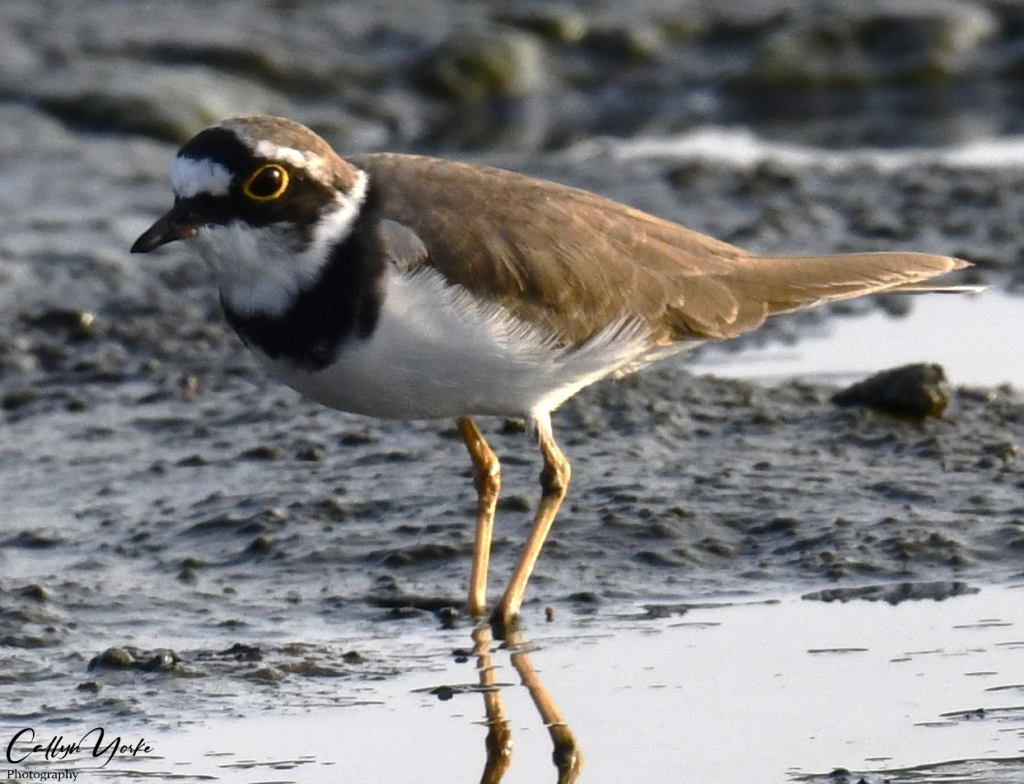
- Kentish Plover Charadrius alexandrinus 2 (ad; alt. plmg.) foraging on mudflats, EP (photo).
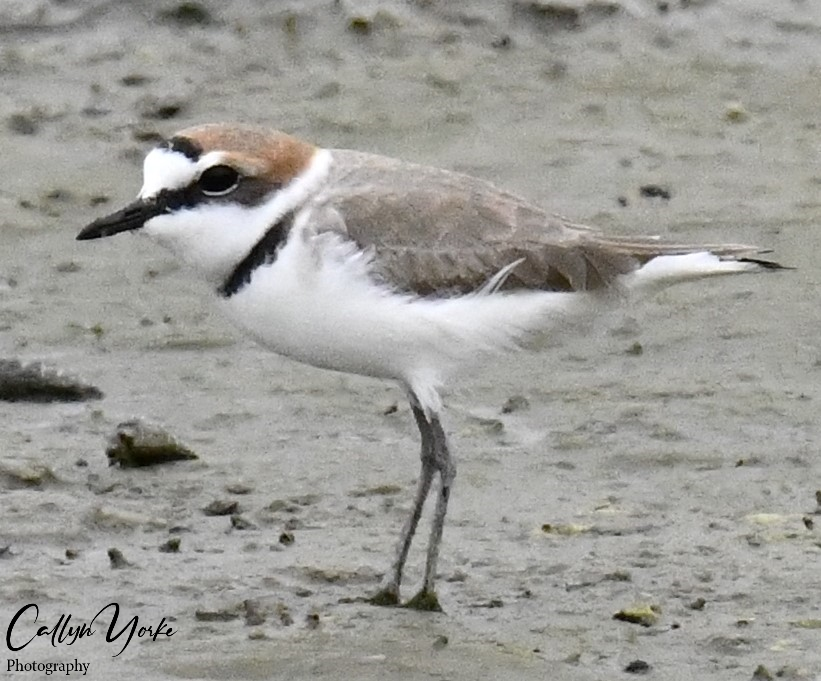
- White-faced Plover Charadrius dealbatus 1 alone on mudflats, EP.
- Greater Sandplover Charadrius leschenaultii 12 (bsc. and trans. alt. plmg.) greg. individuals, pairs and small flocks on mudflats and saltpans, EP, CP.
- Pheasant-tailed Jacana Hydrophasianus chirurgus 3 (bsc. plmg.) greg. interacting by running short distances with wings raised; on outer edge of lily pond and lake open water, WSHA.
- Broad-billed Sandpiper Calidris falcinellus 1 with LTST and GRSP on mudflats, EP.
- Long-toed Stint Calidris subminuta 12 (bsc. plmg.) greg. pairs and trios foraging on mudflats, sometimes showing intraspecific aggression (chasing), EP, CP (photo).
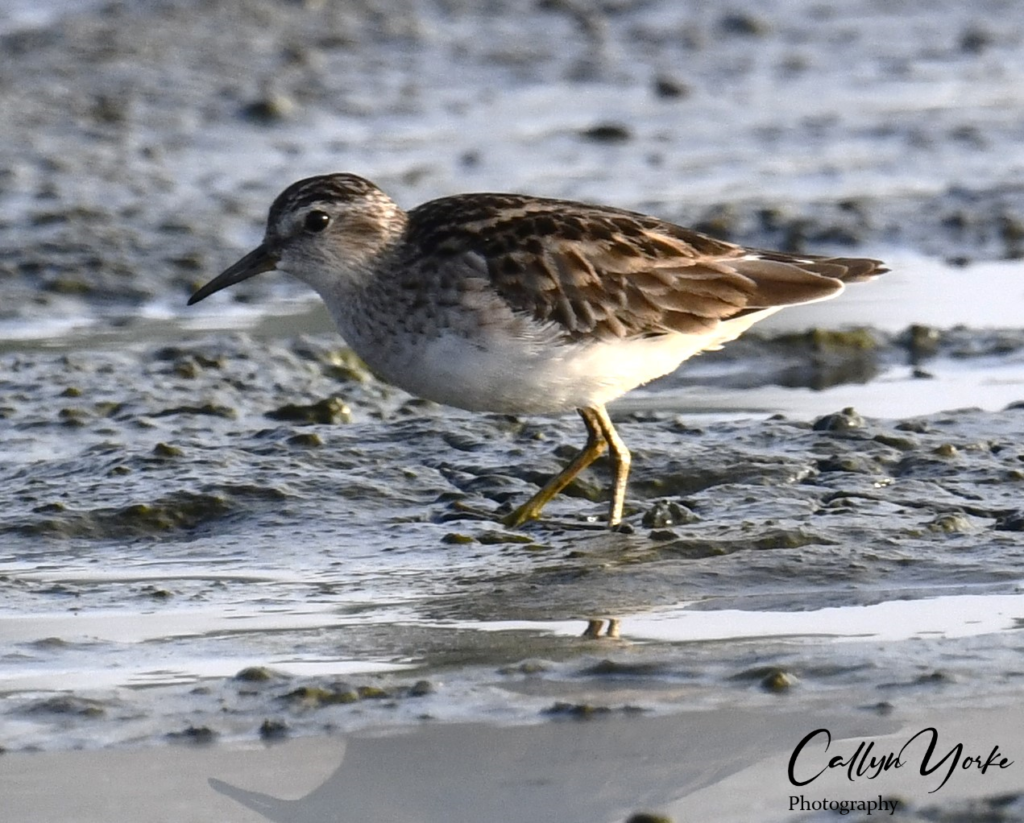
- Red-necked Stint Calidris ruficollis (NT) 90 (bsc. plmg.; one in trans. alt. plmg.) a large, cohesive flock of about 80 birds foraging in shallows of sw pond; taking flight, circling the area and returning, CP; EP (photos).
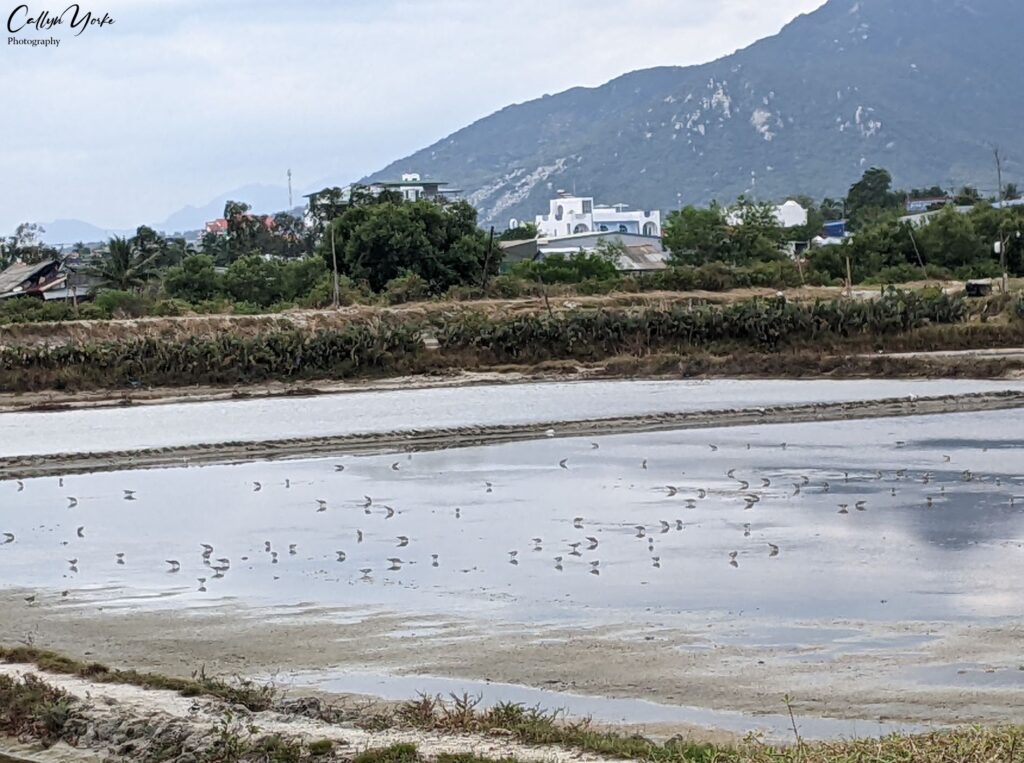
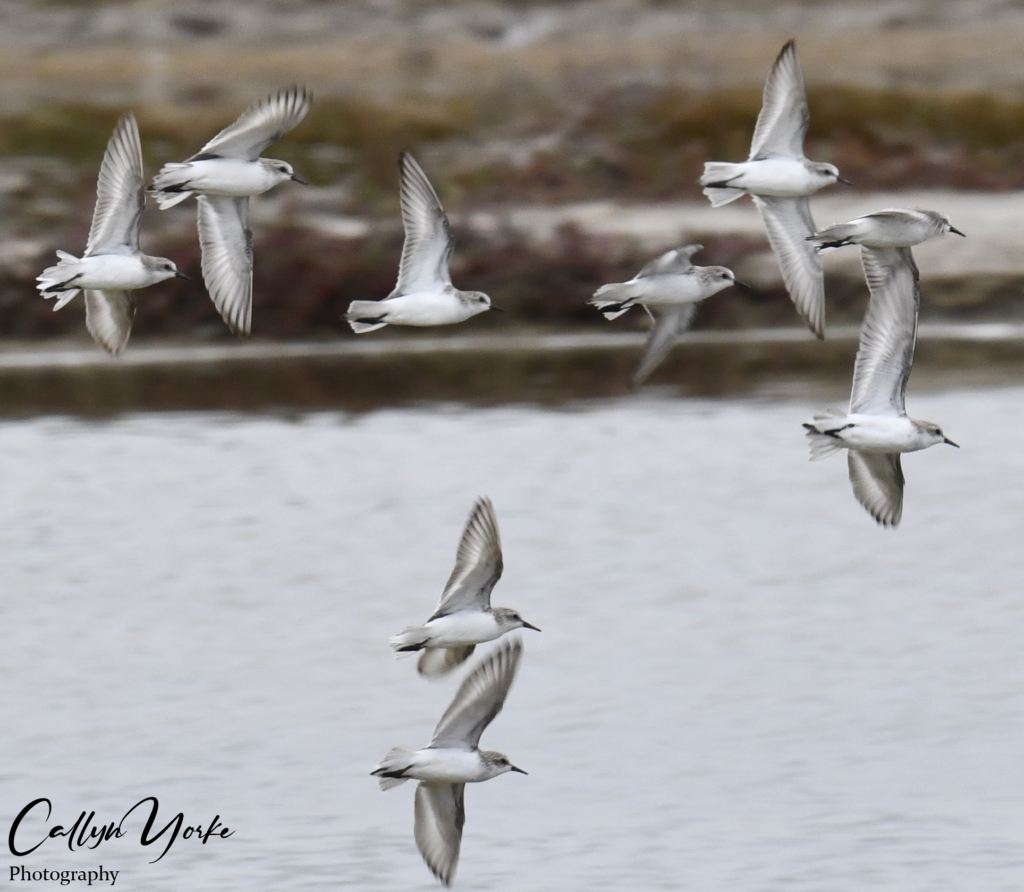
- Sanderling Calidris alba 4 (bsc. plmg.) greg. standing on levee at edge of sw pond with nearby RNST; foraging in shallows, CP (photo).
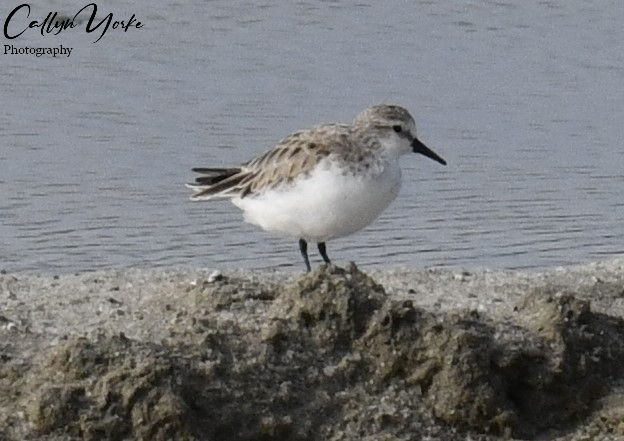
- Common Sandpiper Actitis hypoleucos 2 individuals foraging busily on mudflats in mangrove and edges of ponds; shy and readily flushed, EP, CP (photo).
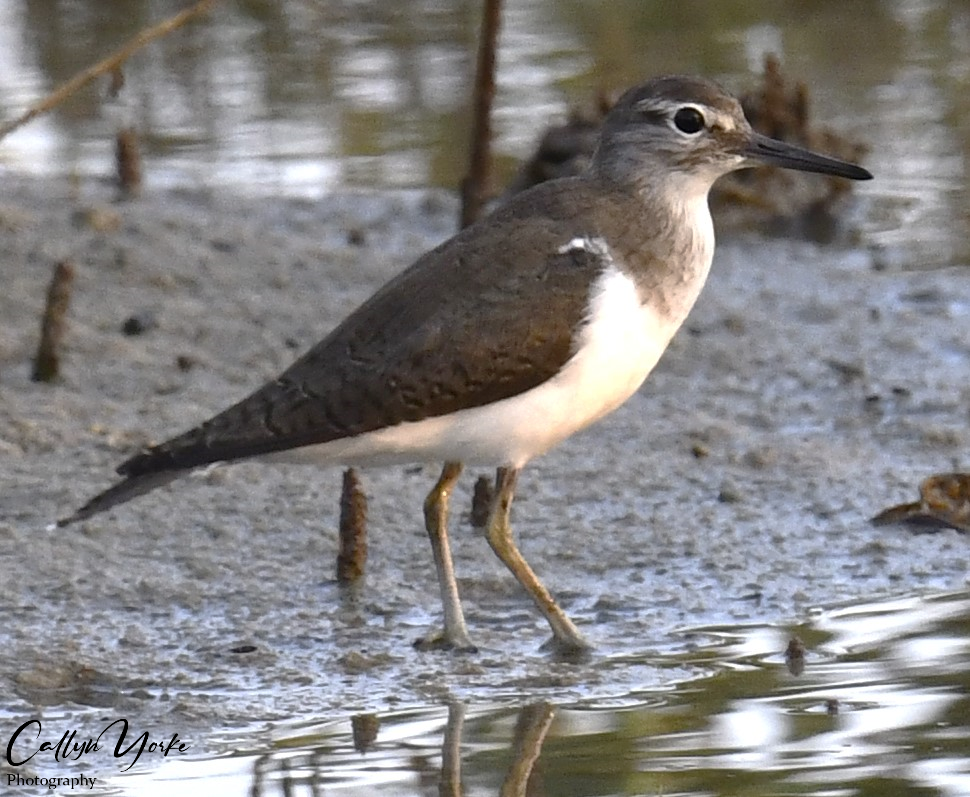
- Common Greenshank Tringa nebularia 1 foraging alone on edges and shallows of ponds, EP.
- Wood Sandpiper Tringa glareola 16 (ad, imm; bsc. and trans. alt. plmg.) greg. foraging with bobbing motions, on mudflats, in pond and mangrove shallows; resting in pickleweed and wet grass; relatively confiding, CP; EP; WSMP (photo).
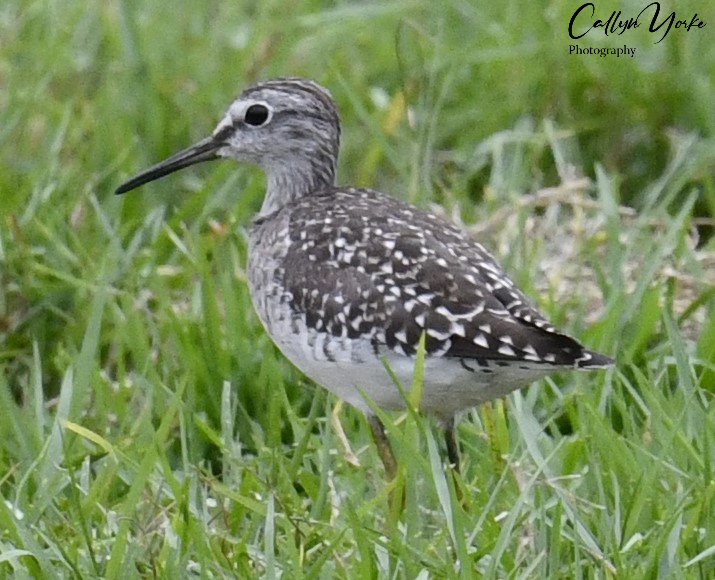
- Marsh Sandpiper Tringa stagnatilis 12 (bsc. plmg.) greg. foraging busily in shallows of ponds and saltpans, EP, CP.
- Asian Green Bee-eater Merops orientalis 5 greg. sallying from low utility wires and shrubs in clearings, ubiq. (photo).
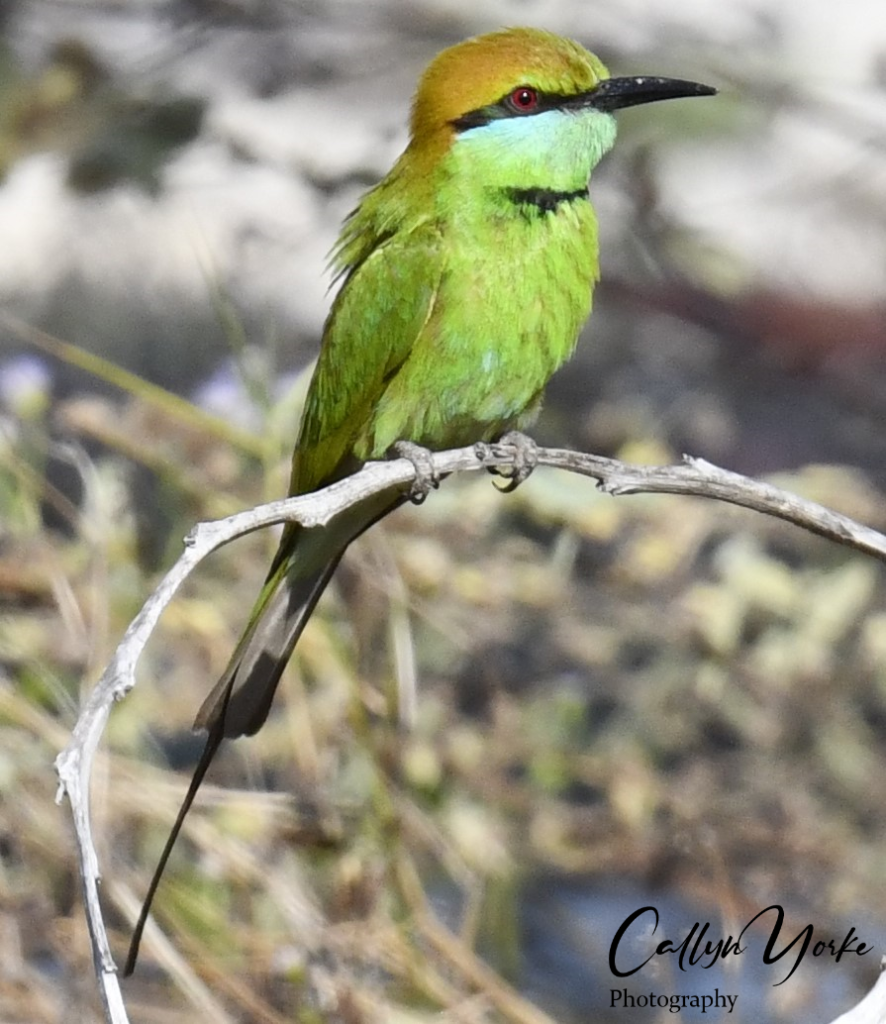
- Blue-tailed Bee-eater Merops philippinus 4 greg. sallying from tree canopy and utility wires; aerial hawking with upward trajectories from a tree canopy; occasionally in same area with AGBE but the two species usually not within 50m of each other, WSA; CP (photo).
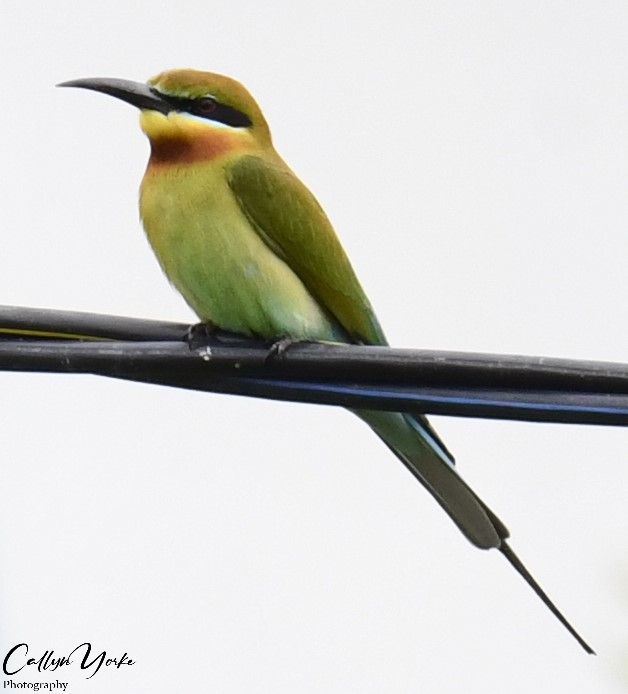
- Common Kingfisher Alcedo atthis 1 sallying out from edge of mangrove and diving into pond shallows, EP.
- White-breasted Kingfisher Halcyon smyrnensis 1 vocal in Acacia woods adjacent to lotus lily lake, WSA.
- Common Iora Aegethina tiphia 1 in Acacia canopy and ornamental garden trees, NH.
- Black Drongo Dicrurus macrocercus 1 flying between trees in coastal scrub, west side of coast resort highway (DT 6571).
- Burmese Shrike Lanius collurioides 1 perched in tall shrub at edge of coastal scrub clearing, ECRB.
- Indochinese Bushlark Mirafra erythrocephala 1 on roadside utility line in clearing of sand-mine and coastal scrub, WSA.
- Plain Prinia Prinia inornata 6 (ad. and one fledgling), vocal, loosely greg. in coastal scrub and mangrove edge, ubiq. (photo).
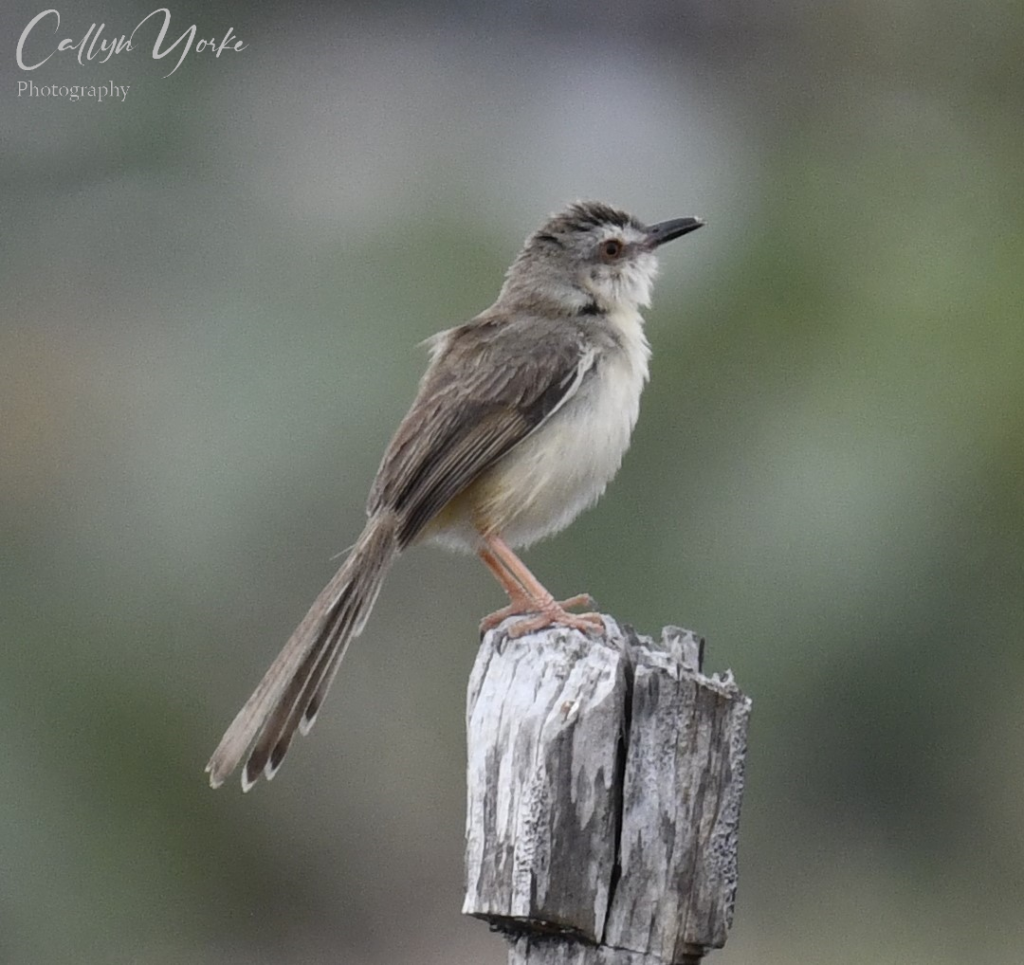
- Oriental Reed-warbler Acrocephalus orientalis 6 vocal, loosely greg. remaining well hidden in mangrove and adjacent shrubs in coastal scrub adjacent to ponds and mudflats, CP; EP; WSM.
- Lanceolated Warbler Locustella lanceolata 1 vocal but secretive and difficult to see clearly; staying low in shrubs and tall grass, NH.
- Eurasian Barn Swallow Hirundo rustica 30 greg. roosting on ledges at front of hotel; flying low over ponds and mudflats; resting on utility wires, ubiq.
- Red-whiskered Bulbul Pycnonotus jocosus 1 vocal, flying over pond and into adjacent home garden, NH.
- Streak-eared Bulbul Pycnonotus conradi 12 vocal, greg. in gardens, coastal scrub, mangrove, ubiq..
- Dusky Warbler Phylloscopus fuscatus 1 foraging actively, grasping aerial roots of at base of regenerating mangrove, at high tide, CP (photo).
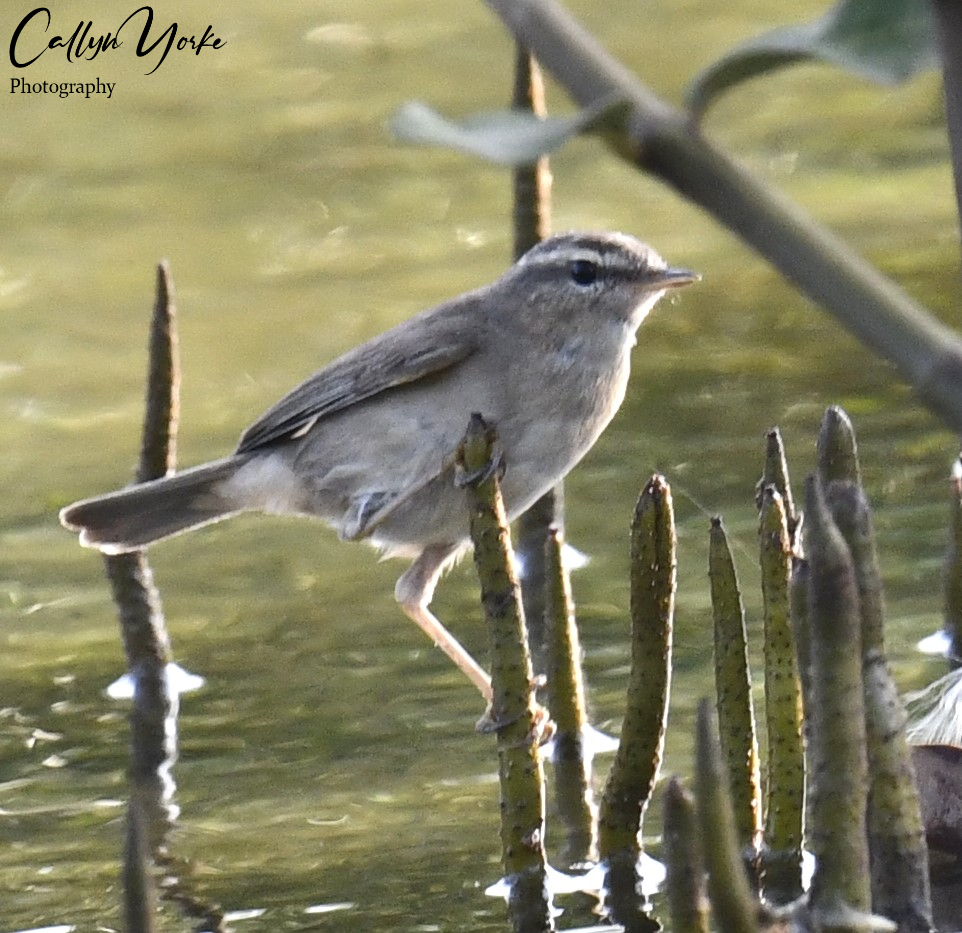
- White-shouldered Starling Sturnia sinensis 18 greg. cohesive flocks flying to ornamental fruiting trees around neighborhood, NH; CP.
- Common Myna Acridotheres tristis 4 vocal; pairs on buildings, in gardens and pasture, ubiq..
- Purple Sunbird Cinnyris asiaticus 3 (m,f) greg. vocal, a trio of two females and a male briefly visiting flowering shrubs and small trees, ECRB.
- Ornate Sunbird Cinnyris ornatus 3 (m,f) vocal, loosely greg. visiting flowering trees and shrubs in gardens and coastal scrub, ubiq..
- Scaly-breasted Munia Lonchura nisoria 8 (m,f; ad. imm.) greg. frequenting low shrubs and tall grass at edge of clearings, ubiq..
- Indian Sparrow Passer indicus 10 (m,f) vocal, greg. on and around buildings, gardens, pasture and clearings in coastal scrub near settlements; sympatric with EUTS, ubiq..
- Eurasian Tree Sparrow Passer montanus 40 (m,f) vocal, greg. on and around buildings, gardens, pasture, mangrove and coastal scrub; numerically dominant to INSP, except where co-occurring in close proximity. Mostly, these two congeners remained separated spatially and perhaps ecologically.
- Paddyfield Pipit Anthus rufulus 6 individuals and pairs on ground in pasture and clearings in coastal scrub, including sand dunes, ubiq..
- Eastern Yellow Wagtail Motacilla tschutschensis 1 (imm.) foraging in tall grass, CP.
- Siberian Wagtail Motacilla ocularis 1 foraging actively on edge of pond and mudflats, EP (photo).
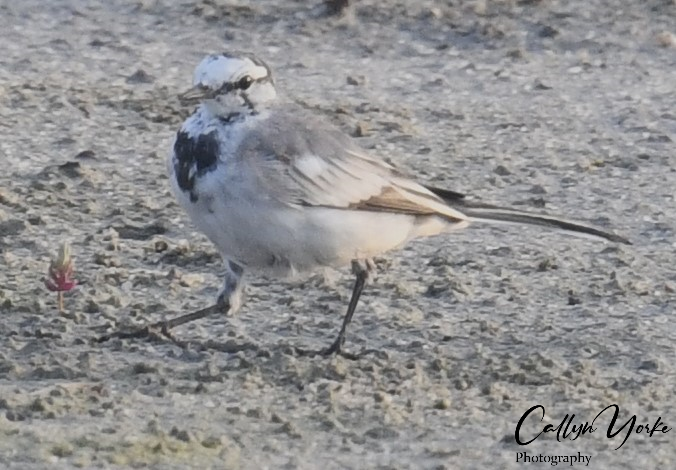
- Chinese Wagtail Motacilla leucopsis 1 foraging actively on a mostly dry saltpan, CP.
___________________________________________________________________
Cam Ranh, Khánh Hòa Province, Việt Nam: 13-15 January 2024 (63 Species)
Callyn Yorke
Survey Dates, Times and Locations (scroll down to previous report, 8-14 November 2023, for detailed area descriptions)
Weather: Partly cloudy, clearing by the early afternoon. Wind: NE, 5-25 kph, increasing throughout the day; no precipitation; Ambient air temperature, 19°C to 27°C.
Time: Sunrise (0530 hrs.) to sunset (1730 hrs.); primarily early morning and late afternoon, 2-3 hr. surveys.
Observers: Hai-Dang Phan, Ai Phan and I.

Casuarina Ponds Survey (CP): 13 January, 2024: 1145-1230 hrs. A walk-through survey of salt ponds (northeast section), abandoned aquaculture ponds (central & south), mangrove (east), pasture and coastal scrub was made. All bird nets present during the previous surveys in November, 2023 were removed. However, waders were scarce to absent in and around the southern-most ponds during the present survey; several of those ponds were almost completely dry. A small herd of tethered cattle was grazing in the pasture during the survey. A new, barbed wire fence was installed along the west and north roadsides of this area. Access for birding is now primarily in the northeast corner of the site adjacent to the salt ponds.
Navy Hotel East Ponds Survey (NHEP): 13; 14; 15 January, 2024: 1045-1145 hrs.;0600-0640 hrs.; 1700-1750 hrs. 0630-0800 hrs.. Several stationary surveys were made of the abandoned aquaculture ponds and adjacent mangrove. The coastal scrub and plantings around the Navy Hotel were also surveyed while in transit to the ponds and other locations in the area.
West Ponds and Marsh (Naval Base Property – Permission for Entry Required – WSPM): 14 January, 2024: 0800- 0815 hrs.). Note: Due to a recent increase in military security, we were asked to leave soon after arriving and made only a cursory visual survey of the area near the main highway (QL1A) entrance.

West Cam Ranh Bay shoreline and mudflats (WCRB): 14 January, 2024: 0820-0835 hrs. This was a brief survey of the western bay shore and mudflats at low tide. Clammers and other locals were on the mudflats during this time; shorebirds were scarce.
White Sands Hotel Area (WSH): 14 January, 2024: 0840- 0915 hrs.. We walked through this area where I had found Great Thicknee during a previous survey (11 November, 2023). Three individuals of this species were found during the present survey, in addition to a few other bird species (see Annotated Bird List).
Anam Resort Area (ARA): 14 January, 2024: 1400-1500 hrs. We made an afternoon walking survey through the coastal dune-scrub, abandoned development area.
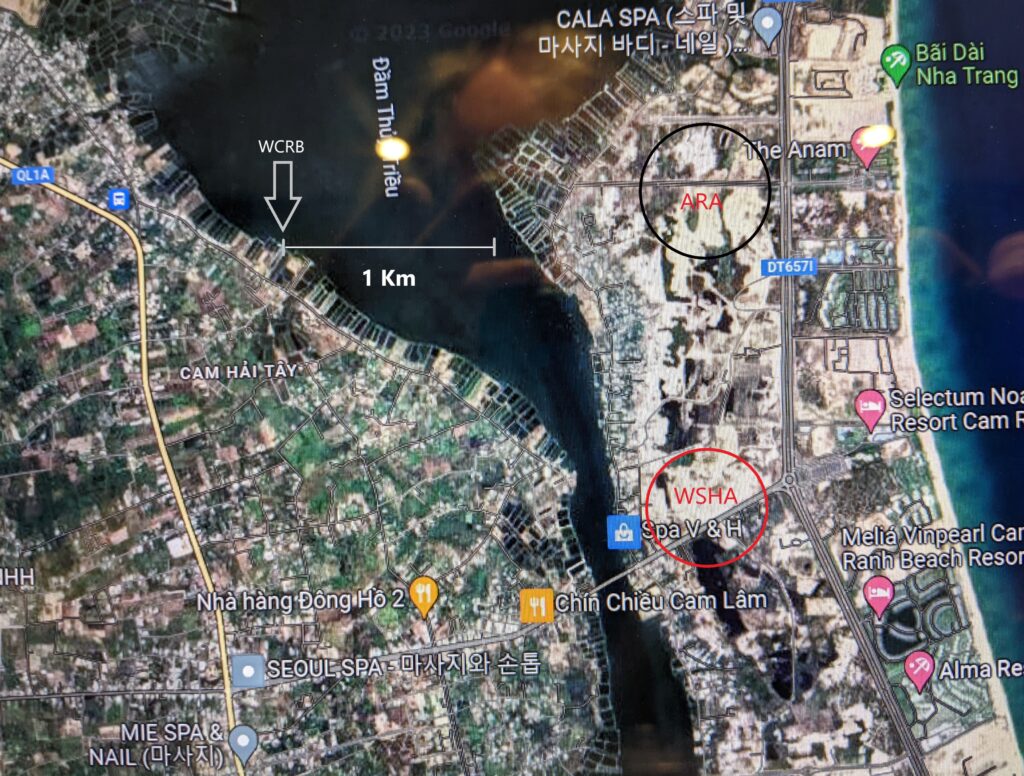
Annotated Bird List – Cam Ranh Bay Area – January 13-15, 2024 Callyn Yorke
LEGEND
Abundance: Numbers following each species entry are the highest count for a single survey, when multiple surveys at a particular location were made. Locations (see below) with the highest numerical abundance are listed first in the species accounts. When only one of us found a particular bird species, their initials are given at the end of the species account: Hai-Dang Phan (HDP); Ai Phan (AI); Callyn Yorke (CDY).
Age, sex and molt (when known): ad = adult; imm = immature; m = male; f = female; bsc plmg = basic (non-breeding plumage; alt plmg = alternate (breeding) plumage; trans = transitional plumage, e.g. alternate into basic plumage.
Survey Location Abbreviations (see preceeding maps): NH = Navy Hotel grounds; NHEP = Navy Hotel east aquaculture ponds and mangrove; CP = Casuarina Ponds, mangrove, coastal scrub, casuarinas and pasture; WSPM = Western Ponds and Marsh; WCRB = West Cam Ranh Bay shoreline and mudflats; WSHA = White Sand Hotel Area, Bai Dai; ARA = Anam Resort Area, Bai Dai; Ubiq = Ubiquitous in appropriate habitat.
Ecology and Behavior: aerial insect hawking (ah); taking fruit, berries or parts of flowers (fr); gleaning insects from foliage (ig); probing into surface (pr); estimated height (m) above ground (agl); gregarious (greg); mixed-species flock (msf).
Systematics and Nomenclature used herein, is an amalgam of Avibase, International Ornithological Congress (IOC) and current (2024) online resources, i.e. Birds of the World, Cornell University, USA.
Note: Species of Special Concern, i.e. listed by IUCN as Near Threatened (NT); Vulnerable (VU); Endangered (EN); Critically Endangered (CR), are shown with bold-face type.
Birds Noted
- Chinese Swan Goose Anser cygnoides (domestic) 5 greg. on ground in and around military barracks yard, CP.
- Spot-billed Duck Anas sp. c.f. poecilorhyncha 3 greg. pairs swimming in lotus ponds, WSPM; WSHA.
- Feral Rock Pigeon Columba livia 8 greg. in pasture and adjacent suburbs, CP.
- Red Turtle-dove Streptopelia tranquebarica 5 greg. on utility wires, NH.
- Eastern Spotted Dove Spilopelia chinensis 2 greg. pair in flight, ARA.
- Zebra Dove Geopelia striata 12 greg. vocal; on ground and utility wires, ubiq..
- Germain’s Swiftlet Aerodramus germani 80 greg. flying 0.2m over ponds at dusk to 75m agl., ubiq..
- Asian Palm Swift Cypsiurus balasiensis 2 greg. a pair flying 8-20m agl, NH.
- Greater Coucal Centropus sinensis 5 vocal, individuals and pairs in tall coastal scrub; ubiq..
- Western Koel Eudynamys scolopaceus 1 vocal (unseen) in a homestead garden tree, WCRB.
- Plaintive Cuckoo Cacomantis merulinus 1 flying over roadway, NH-CP.
- White-breasted Waterhen Amaurornis phoenicurus 5 greg. edge of lotus pond and mangrove, NH; NHEP.
- White-browed Crake Amaurornis cinerea 3 (ad, imm) greg.; walking in tall grass at edge of wetland-pasture, CP.
- Common Moorhen Gallinula chloropus 2 greg. swimming in large lotus pond, WSHA.
- Striated Heron Butorides striata 3 (ad, imm. – comparatively dark plumage, initially inviting confusion with Black Bittern) individuals wading in shallows; walking on embankments; foraging at edge of ponds, NHEP; CP (photo).
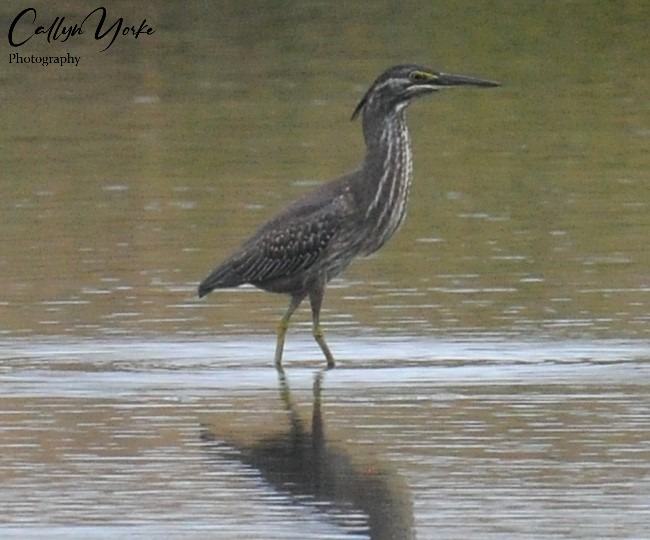
- Chinese Pond Heron Ardeola bacchus 25 loosely greg. standing at edges of ponds and in grassy wetlands; often seen in flight over those areas, ubiq..
- Gray Heron Ardea cinerea 1 in flight 40m agl over wetlands, at dawn; ubiq.
- Purple Heron Ardea purpurea 1 in flight 30m agl over wetlands, ARA.
- Eastern Great Egret Ardea modesta 1 standing at edge of pond, ARA.
- Intermediate Egret Ardea intermedia 6 greg. at edge of ponds and wetlands; ubiq..
- Little Egret Egretta garzetta 25 greg. wading in shallows; standing at edges of ponds and in wetlands; roosting in tall trees bordering CP–NH; ubiq..
- Little Cormorant Microcarbo niger 60 (ad, imm) greg. perched on fencing in water, large lotus pond in WSHA; individuals in flight at dawn, 20- 30m agl, ubiq..
- Indian Cormorant Phalacrocorax fuscicollis 1 perched with LICO on fencing in water, large lotus pond in WSHA.
- Great Thicknee Esacus recurvirostris (NT) 3 greg. two adults standing within 2m of each other; another individual about 4m away on embankment at edge of water-filled sand mining pit; birds hesitated, reluctant to fly and holding still for several minutes; all three flushed to base of dune hillside about 200m away. WSHA (photo).

- Little Ringed Plover Charadrius dubius 10 (bsc., alt. plmg.) greg. pairs on edge of ponds and mangrove, CP.
- Mongolian Sandplover Charadrius mongolus 1 in shallows and on berm with GRSA, NHEP (photo).

- Greater Sandplover Charadrius leschenaultii 10 greg. on edges of ponds, NHEP; CP.
- Black-necked Lapwing Vanellus atronuchalis 2 WSHA (HDP).
- Pheasant-tailed Jacana Hydrophasianus chirurgus 1 (bsc. plmg.) in large lotus pond, WSHA.
- Broad-billed Sandpiper Calidris falcinellus 6 (bsc. plmg.) greg. foraging (pr) in pond shallows, NHEP.
- Long-toed Stint Calidris subminuta 7 (bsc. plmg.) greg. foraging in pond shallows, NHEP; CP (photo).
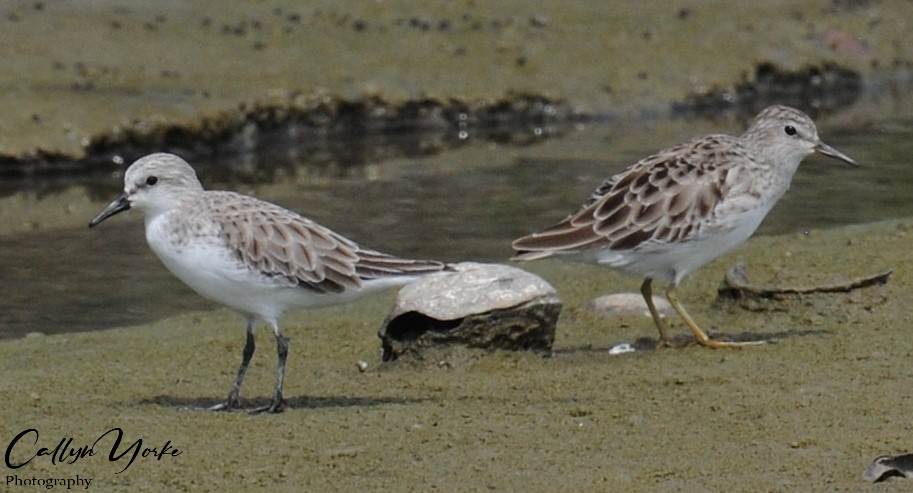
- Red-necked Stint Calidris ruficollis (NT) 12 (bsc. plmg.) greg. on berms and in pond shallows, NHEP (photo).
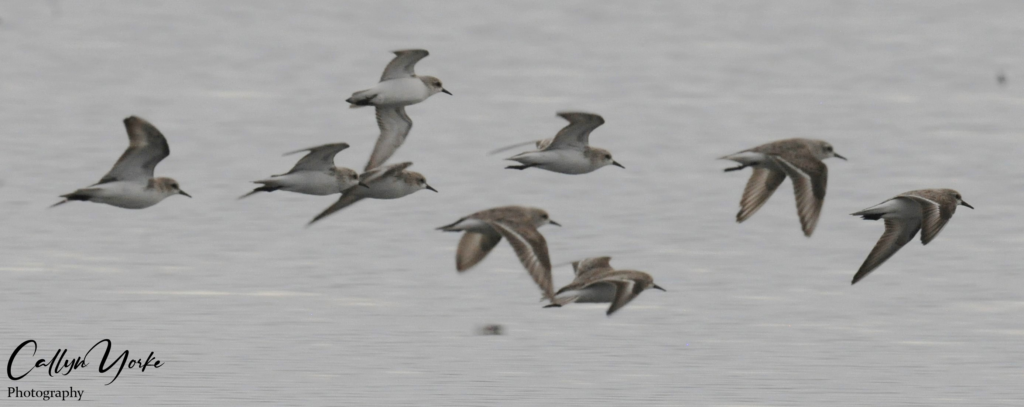
- Sanderling Calidris alba 1 (bsc. plmg.) with other Calidris spp. on berms and in pond shallows, NHEP.
- Common Sandpiper Actitis hypoleucos 1 berms at edge of ponds, NHEP; CP.
- Common Greenshank Tringa nebularia 15 (bsc. plmg.) loosely greg. on mudflats and in pond shallows, WCRB; NHEP; CP.
- Wood Sandpiper Tringa glareola 4 (bsc. plmg.) loosely greg. in tall, wet grass and edge of ponds, CP (photo).
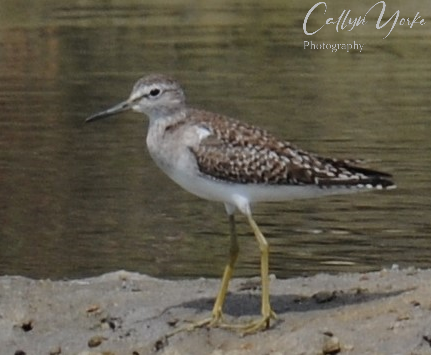
- Marsh Sandpiper Tringa stagnatilis 10 (bsc. plmg.) greg. confiding; wading and foraging (pr) in pond shallows, NHEP.
- Asian Green Bee-eater Merops orientalis 5 greg. sallying from 0.5 – 3m perch in open areas; ubiq..
- Blue-tailed Bee-eater Merops philippinus 2 sallying out over lotus pond, WSHA.
- Common Kingfisher Alcedo atthis 1 in low shrubs and mangrove at edge of ponds, CP; NHEP.
- White-breasted Kingfisher Halcyon smyrnensis 2 vocal; individuals in trees and on utility lines, mangrove, ponds and open fields; ubiq..
- Golden-bellied Gerygone Gerygone sulphurea 1 vocal in fringing mangrove, NHEP.
- Black Drongo Dicrurus macrocercus 2 greg. a pair sallying from trees at edge of large lotus pond, WSHA.
- Burmese Shrike Lanius collurioides 5 on utility lines and perched 4-5m agl in isolated trees; open areas with coastal scrub, mangrove and wetland-pasture, WSPM; WCRB; CP.
- Indochinese Bushlark Mirafra erythrocephala 5 greg. on utility lines and 3-5m agl in trees, coastal scrub edge, ARA (photo).
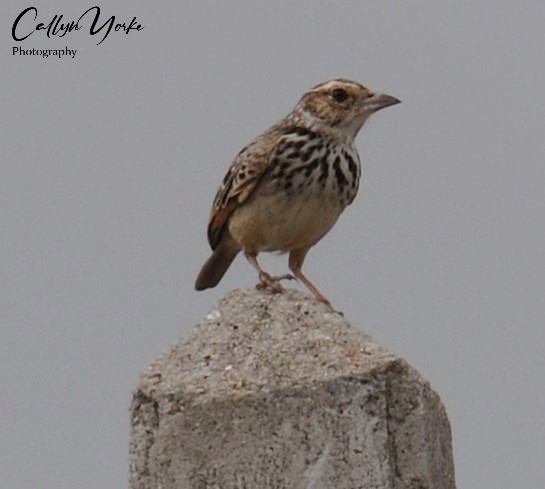
- Plain Prinia Prinia inornata 5 vocal, greg. pairs in dense coastal scrub and edge of mangrove, ARA; NHEP; CP.
- Common Tailorbird Orthotomus sutorius 2 vocal (unseen) in dense coastal scrub, NH; ARA.
- Oriental Reed-warbler Acrocephalus orientalis 4 vocal in mangrove at edges of ponds, NHEP; CP.
- Eurasian Barn Swallow Hirundo rustica 25 greg. flying 0.2 – 20m agl; ubiq..
- Streak-eared Bulbul Pycnonotus conradi 25 greg. vocal; active in shrubs and trees; coastal scrub, mangrove, gardens; ubiq..
- Yellow-browed Warbler Phylloscopus inornatus 1 a grove of deciduous trees bordering large lotus pond, WSHA (HDP).
- Black-collared Starling Gracupica nigricollis 1 vocal (unseen) in bordering grove of trees, NHEP.
- Common Myna Acridotheres tristis 2 vocal, flying over open area, NH.
- White-shouldered Starling Sturnia sinensis 5 greg. in flight, sw 15-20m agl, NHEP–CP.
- Ornate Sunbird Cinnyris ornatus 4 (m,f) greg. in shrubs at edge of dune escarpment, ARA.
- Scaly-breasted Munia Lonchura nisoria 12 (m,f; ad., imm) greg. vocal, in low shrubs, then flushing to emergent trees, coastal scrub, ARA.
- Indian Sparrow Passer indicus 10 (m,f) greg. vocal, mostly on ground and lawns; sympatric with TRSP but usually spatially separate, NH; WCRB.
- Plain-backed Sparrow Passer flaveolus (m,f) 8 greg. moving around frequently in shrubs and trees, dense coastal dune-scrub; ARA.
- Eurasian Tree Sparrow Passer montanus 30 (m,f) greg. vocal; large flocks foraging on ground at edge of ponds and mangrove at sunset; flushing to trees and buildings; sympatric with INSP but usually spatially separate; ubiq..
- Paddyfield Pipit Anthus rufulus 10 loosely greg. frequenting open areas with sand, mud, bare ground or short grass; ubiq.
- Eastern Yellow Wagtail Motacilla tschutschensis 1 in short grass, mudflats and on pond berms, NHEP; CP (photo).
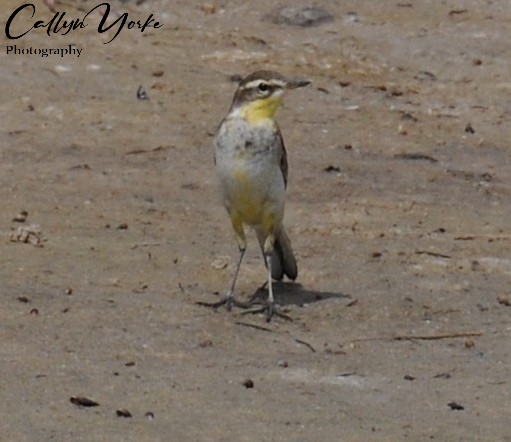
- Chinese Wagtail Motacilla leucopsis 3 indivuals foraging (pr; ig) on mudflats, pond berms and short grass, CP.
- Oriental Greenfinch Chloris sinica 1 m (bsc. plmg.) in short grass on pond embankment, NHEP.
______________________________________________________________
Cam Ranh, Khánh Hòa Province, Việt Nam: 8-14 November 2023 (64 Species)
Callyn Yorke
Introduction
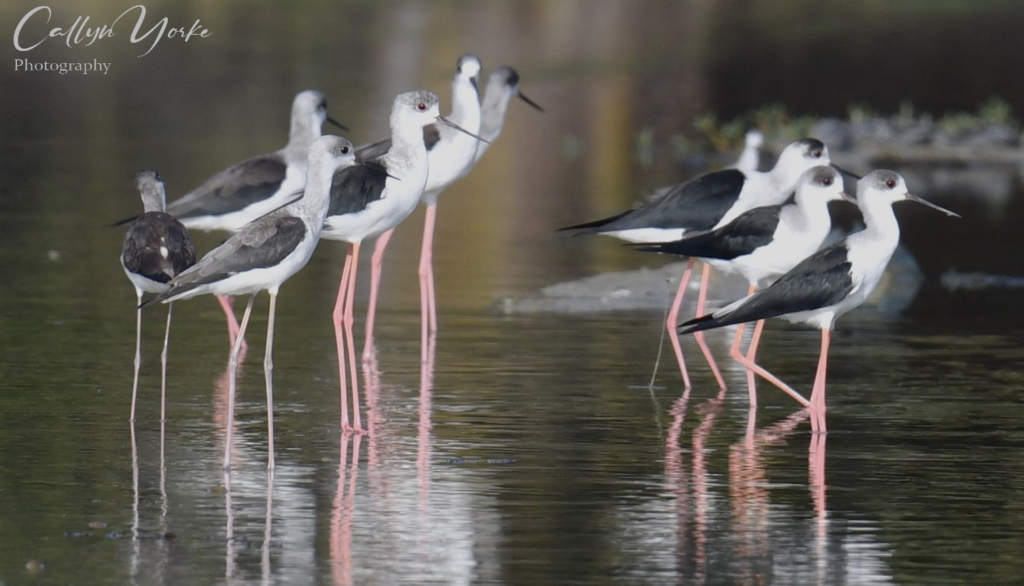
Since my initial visit to Cam Ranh Bay (CRB) in July, 2019, I have made multiple birding surveys there, mainly in the west-central and northern sections. Cam Ranh Bay has been variously developed for residential, commercial, farming and light industrial purposes, e.g. housing tracts, hotels & resorts, aquaculture farms, eidible bird nests, silviculture and pastureland. Property within the jurisdiction of Cam Ranh International Airport and adjacent Cam Ranh Bay Naval Base, is largely inaccessible to the public and off limits to birders. Bay waters, particularly on the west side, are congested with aquaculture ponds, tidal fish traps and nets, floating docks and boats; shorelines are frequented by locals and heavily polluted with trash. Most of the migratory birds have shifted to largely vacant wetlands and abandoned aquaculture ponds scattered around the bay.

Military presence in the Cam Ranh Bay area incidentally provides protection for hundreds of hectares of coastal wetlands, including habitat used by migratory birds. For that reason, it is unsurprising that Cam Rahn Bay remains as one of the premier birding areas in coastal Vietnam. The Cam Ranh Bay area, although not yet officially recognized as such, is well deserving of being designated as an internationally important bird area (IBA).
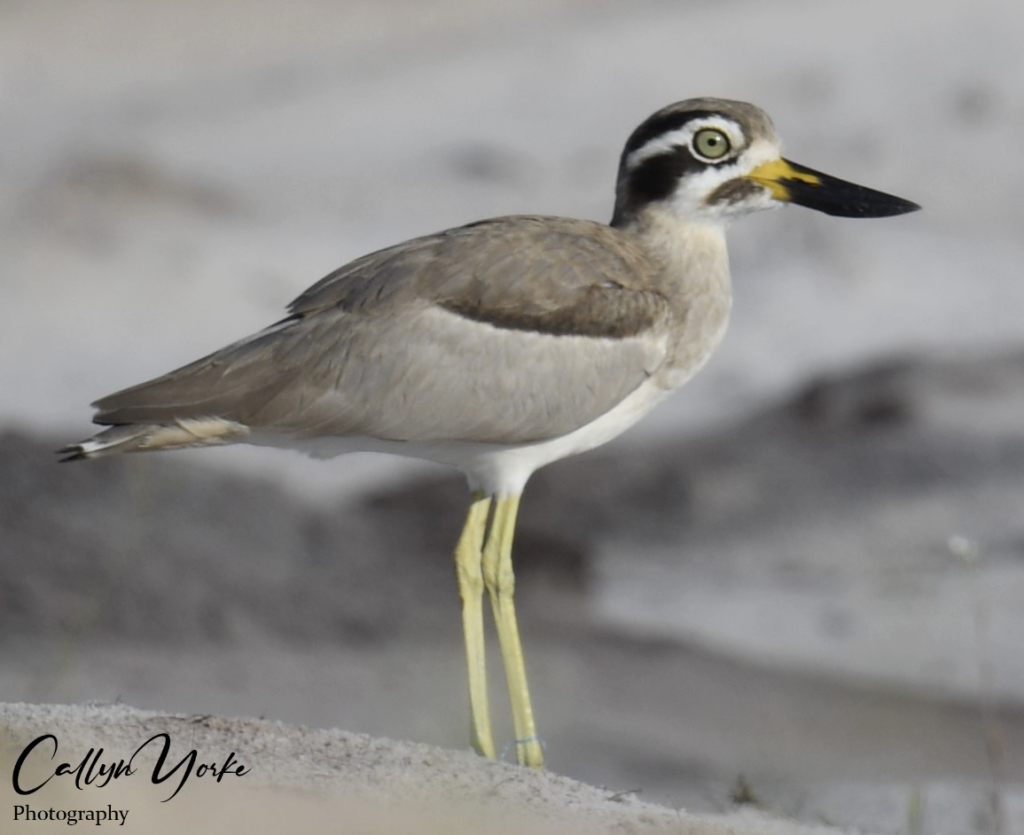
Birding accessibility in Cam Ranh Bay can be problematic. Many locations, several kilometers apart, are served only by foot paths and unpaved roads, often muddy and potholed. A motorbike is a practical form of transportation in such areas. Birding hotspots tend to be in relatively quiet, vacant fields with marshes, abandoned aquaculture ponds and pastures used for grazing small herds of cattle.

Two easily accessible places for observing migratory waterbirds are within a few minutes walking distance of the Navy Hotel, located on the north side of Nguyễn Chi Thanh road in the west-central section of Cam Ranh Bay (see attached map). The two locations (CP and NHEP), have consistently produced an impressive variety of migratory and resident waterbirds. These two areas combined include tidal aquaculture ponds, regenerating mangrove and a small, wet pasture. Conveniently, the adjacent Navy Hotel (3.5 star) offers decent, affordable accommodations (US $30/night, breakfast included), together with a birder-friendly hotel manager, Mr. Mai Minh Sơn. Motorbike rentals (US $6/day) are readily arranged by the hotel staff.
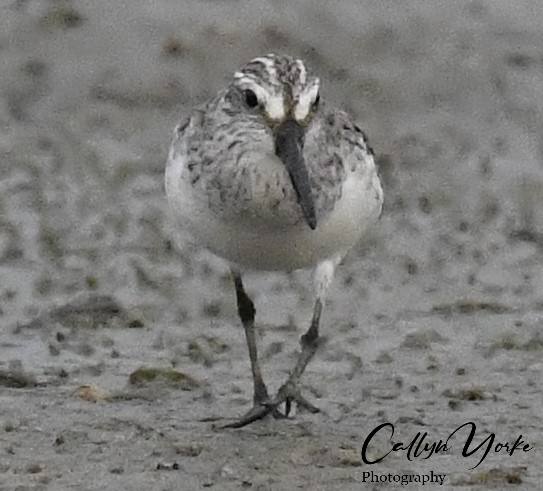
About ten kilometers northeast of the Navy Hotel, in the Bãi Dài area, there is a somewhat different assemblage of birds in the comparatively dry coastal dunes, east of the Cầu Mới bridge (Bãi Dài crossover on Đinh Tiên Hoàng road) between the White Sand Hotel (WSHA) and Anam Resort (ARA – see attached map). Habitat features in those locations include a large lily-covered lake and coastal dune scrub. The areas are dominated by sand mining operations (active and inactive), excavations with stagnant water, marsh, stands of introduced wood-chip trees (Acacia spp.), and abandoned residential developments with paved access roads. This is the habitat of Great Thicknee, Painted Snipe, Asian Green Bee-eater, Blue-throated Bee-eater and Blue-tailed Bee-eater.
Survey Dates, Times and Locations
Weather: Partly cloudy with intermittent light rain and showers, mostly in the late afternoons and evenings (a major weather system from the northeast arrived early on 13 November with heavy rains); winds nearly constant though variable in strength, ENE, N NW, 2 -25 kph; 26C to 32C.
Time: Sunrise (0530 hrs.) to sunset (1730 hrs.); primarily early morning and late afternoon, 2-3 hr. surveys.
Areas Covered:

Casuarina Ponds (CP – see map above and previous reports for additional habitat descriptions). Surveys: 9 Nov., 0600-0740 hrs.; 10 Nov., 1020-1100 hrs.; 12 Nov., 1600-1630 hrs.; 14 Nov. 0642-0725 hrs.. This area is across a divided road (Nguyễn Chi Thanh) from the Navy Hotel, behind a row of Casuarina trees, on the southwest side of the Nguyễn Chi Thanh bridge. A series of abandoned aquaculture ponds, measuring roughly 30m x 15m, are inundated and drained with the tides. Southeast ponds remained largely dry; others retained shallow water throughout the tide cycle; the majority of ponds became mudflats at low tide and following heavy rains (e.g. 14 Nov. 2023). Shorebird abundance generally followed the daily tide cycle: low tides had the greatest abundance and diversity of birds in the ponds. Long-legged waders, e.g. Black-winged Stilt, Common Greenshank and Marsh Sandpiper, favored ponds with relatively deep water. White-browed Crake, Striated Heron, Chinese Pond Heron, Yellow Bittern, Common Snipe and Wood Sandpiper, together with a variety of passerines, frequented the regenerating mangrove and coastal scrub.
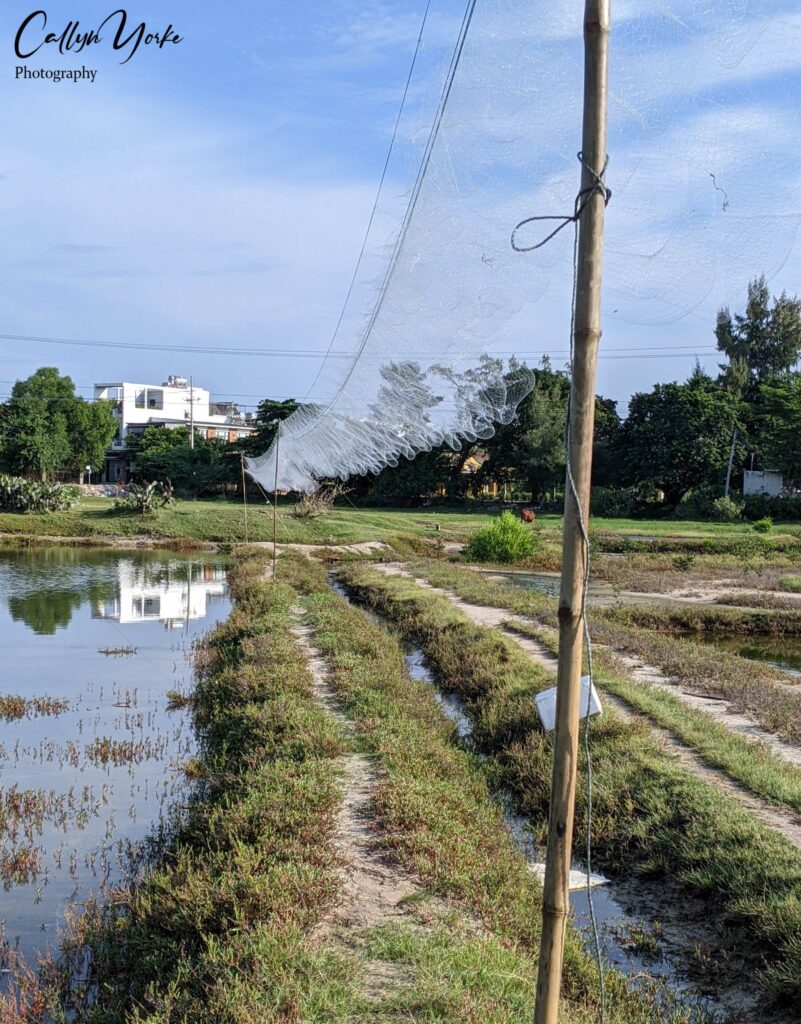
Since my previous survey here in September with Lê Quý Minh (see: Vietnam Coastal Bird Survey 2023), a series of bird nets had been installed around the ponds. Although I did not find any birds caught in the nets during current surveys (five dead Blue-throated Bee-eaters were found in similar nets at this location in September – see following photo), not all the nets were examined closely, particularly an extensive series of bird nets along the southern border of the ponds.
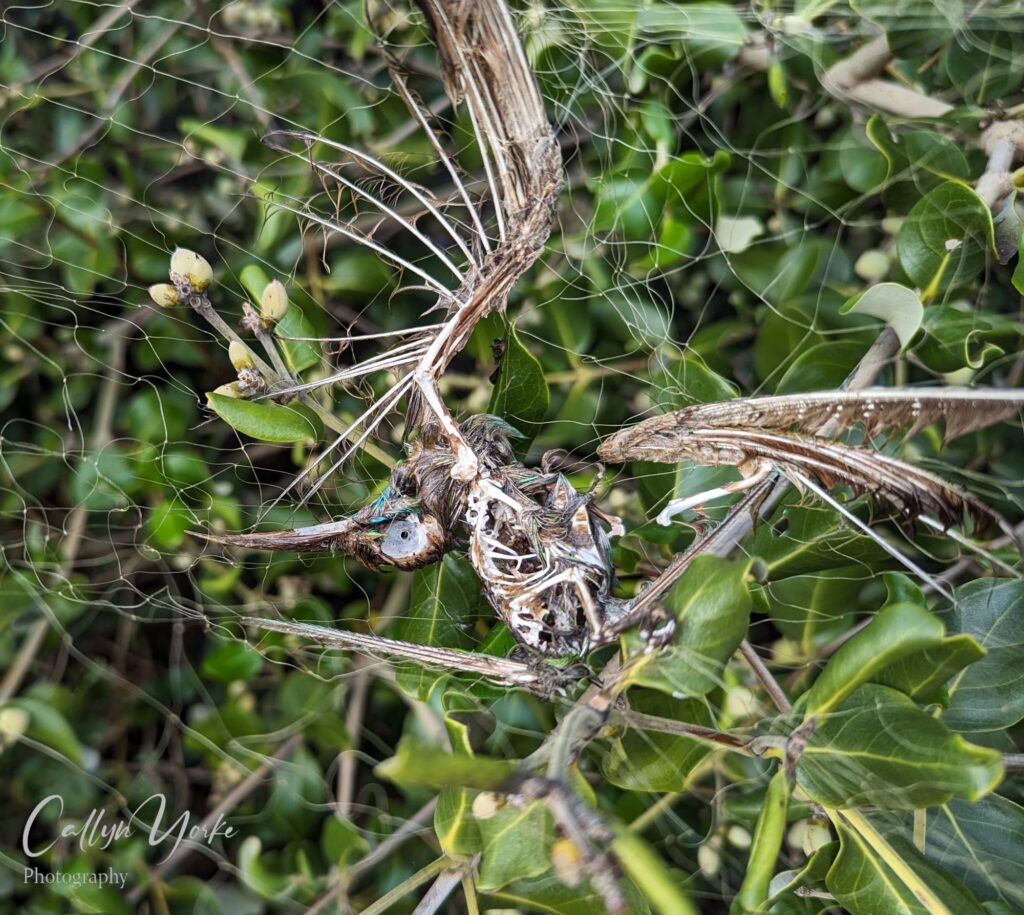
In a discussion with Mr. Mai Minh Sơn, the Navy Hotel manager, I was told that these bird nets were being used illegally on government (Navy) property. Mr. Sơn subsequently visited the site, observed the nets and spoke with local Naval base residents. He said that the Navy base commander would be notified and presumably order the nets to be removed. As of this writing (November 14, 2023) most of the nets remain up (photo).
Adjacent land within the CP survey area, consisted of a small (0.25 ha), marshy pasture (about a dozen head of tethered cattle grazed it fairly regularly), regenerating mangrove and coastal scrub. A windbreak of mature casuarina trees (about 25m in height) formed a border between Nguyễn Chi Thanh road and the mangrove-pond area. Those trees, some with dieback, regularly attracted land birds, e.g. Asian Green Bee-eater and Burmese Shrike. I also surveyed vacant lots in the vicinity of the Navy Hotel (NH). A fence along the southern border of Nguyễn Chi Thanh road was recently installed and seems to have effectively reduced foot traffic and refuse disposal in the CP area.
Navy Hotel East Ponds (NHEP). 8 Nov., 1500-1725 hrs.; 10 Nov. 1120-1215 hrs.; 11 Nov. 1010-1115 hrs.; 12 Nov. 0945-1015 hrs. 14 Nov. 0625-0640 hrs. These tidal aquaculture ponds, located near the northwest corner of Nguyễn Chi Thanh bay bridge, supported a marginal regenerating mangrove that seldom was entirely flooded. The result of partial inundation was that shorebirds could use at least a portion of the area at almost any time, independent of the tides. Consequently, many waterbirds could be observed foraging or resting in and around the ponds during the majority of my surveys.
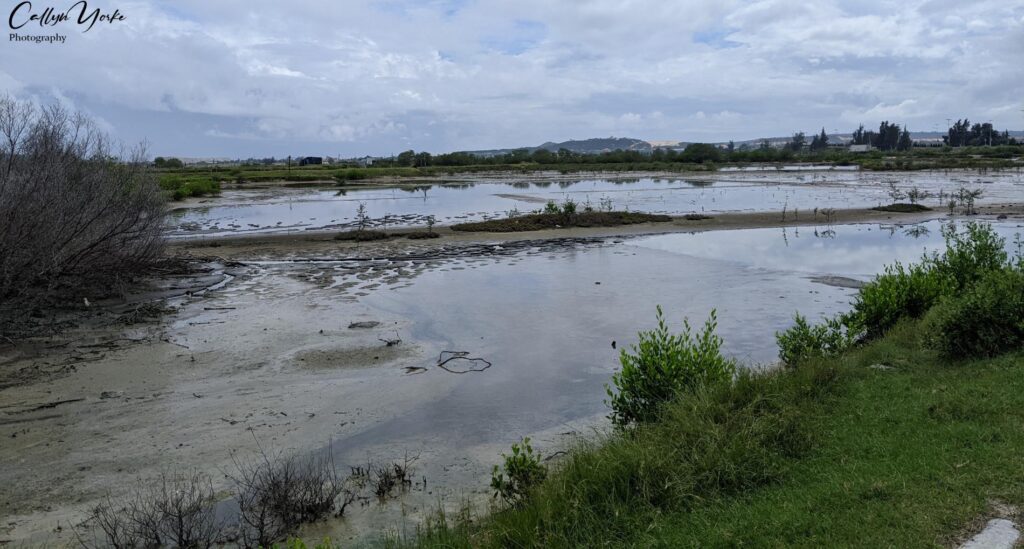
I made observations for an hour or more while seated on a concrete stairway that was embedded into the road embankment. This convenient vantage point was below road level and shielded from passing vehicles on the busy Nguyễn Chi Thanh bridge thoroughfare. After about thirty minutes or so, most of the birds returned to foraging fairly close, e.g. 5-15 m, affording clear views for identification and photos.
Interestingly, the two survey sites, CP and NHEP, separated by a Nguyễn Chi Thanh road and straight-line distances of only 75- 400m, often had significantly different bird species and abundances. For example, Broad-billed Sandpiper was found only at NHEP; Black-winged Stilt, Wood Sandpiper and Long-toed Stint were almost exclusively found at CP. Much larger flocks of Greater Sandplover occurred regularly at NHEP, compared with CP. Lesser Sandplover and Kentish Plover were seldom found at CP, though regular at NHEP. Little-ringed Plover was common in both areas.
Local differences in shorebird abundance and distribution probably related to unmeasured differences in food type and availability (i.e., tiny annelids, mollusks, crustaceans and other arthropods in the wet substrate), combined with behavioral factors, e.g. sensitivity to anthropogenic disturbances.
However, some very conspicuous disturbances, e.g. automobile traffic and noise, which was significant and nearly constant at NHEP, appeared to have little effect on the birds. Evidently, birds quickly habituated to what amounted to irrelevant sound stimuli; those individuals busily foraging in the ponds probably served as recruits for new arrivals. Birds in the ponds kept close tabs on each other and when danger appeared (e.g. a person walking nearby), most would take flight, circle the area, and usually land somewhere away from their most recent foraging area. The fact that many of the birds at NHEP were accustomed to noise and local traffic, made regular close-up observations of them possible and quite delightful, without resorting to the use of any special camouflage gear.
Navy Hotel Grounds (NH). Daily stationary surveys of the rear property (north side) were made, as viewed from my hotel room (#523); walk-through surveys around the hotel were made when going to other locations. Habitats on the hotel grounds included lawns and exotic tree plantings (e.g. Royal Palm and Acacia sp.) and about two hectares of coastal scrub. Species that were found mainly on the hotel property were, Red Turtle Dove, Pink-necked Green Pigeon and Banded Bay Cuckoo.
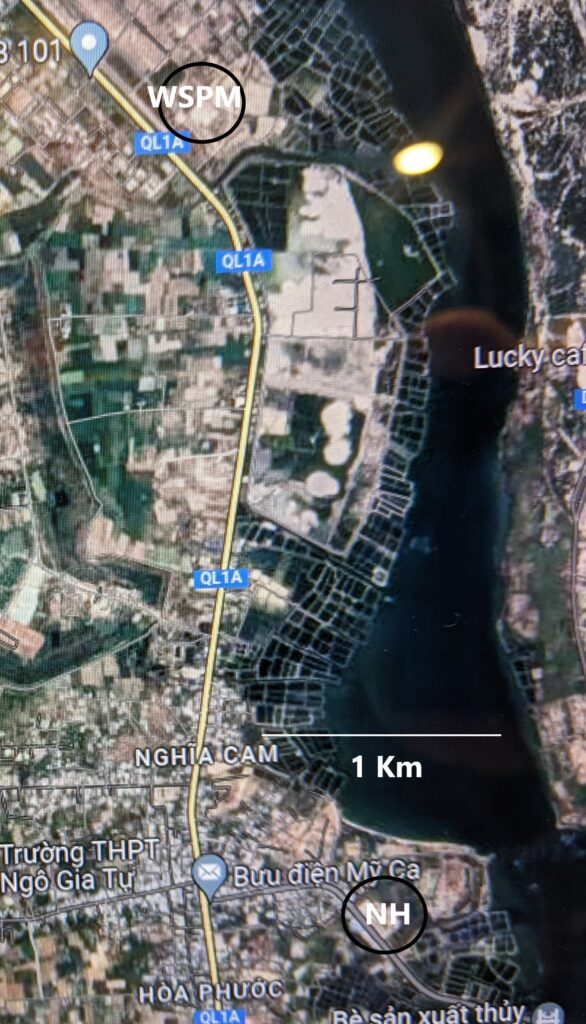
West Ponds and Marsh (WSPM – see preceding map). One survey: 10 Nov. 0615-0800 hrs.. I entered this area on a motorbike, coming north from town on the coast highway (QL1a), then taking the first right past the bridge over a mangrove tidal channel. Almost immediately, I was met by two young Navy guards, who were on duty in the area. Although they didn’t speak much English, within a few minutes, they understood that I was there only to observe birds. I was given the ‘okay’ to continue walking through the area.
This location comprised about five hectares of coastal scrub, marsh, abandoned aquaculture ponds, pasture, a few military bunkers, and a mangrove tidal channel. I surveyed most of it visually, walking on the many cattle paths. Afterwards, I continued by motorbike on a narrow, rough path to the bay shore, which was wildly adventurous though comparatively unproductive.
Birdlife in the military zone, together with several small herds of cattle and villagers commuting back and forth on motorbikes, was fairly conspicuous and abundant. In one large pond, I counted at least ninety Black-winged Stilt. A pasture just east of an old helipad, turned up a cohesive flock of no fewer than twenty-five Pacific Golden Plover. Oriental Reed Warbler was abundant in the area, as evidenced everywhere by their loud, chattering vocalizations. This was the only location surveyed where I found Common Greenshank and Zitting Cisticola.
WSPM was one of the most productive birding locations I visited in the Cam Ranh Bay area. My final tally for the survey of WSPM was thirty-one bird species. There was no evidence of poaching anywhere on the property, which was probably the result of regular military patrols. Visiting birders should be prepared to show their passports and some evidence of the purpose for being on the property. Aside from a brief identification check, I had no further interactions with the military at this or any other location in CRB.
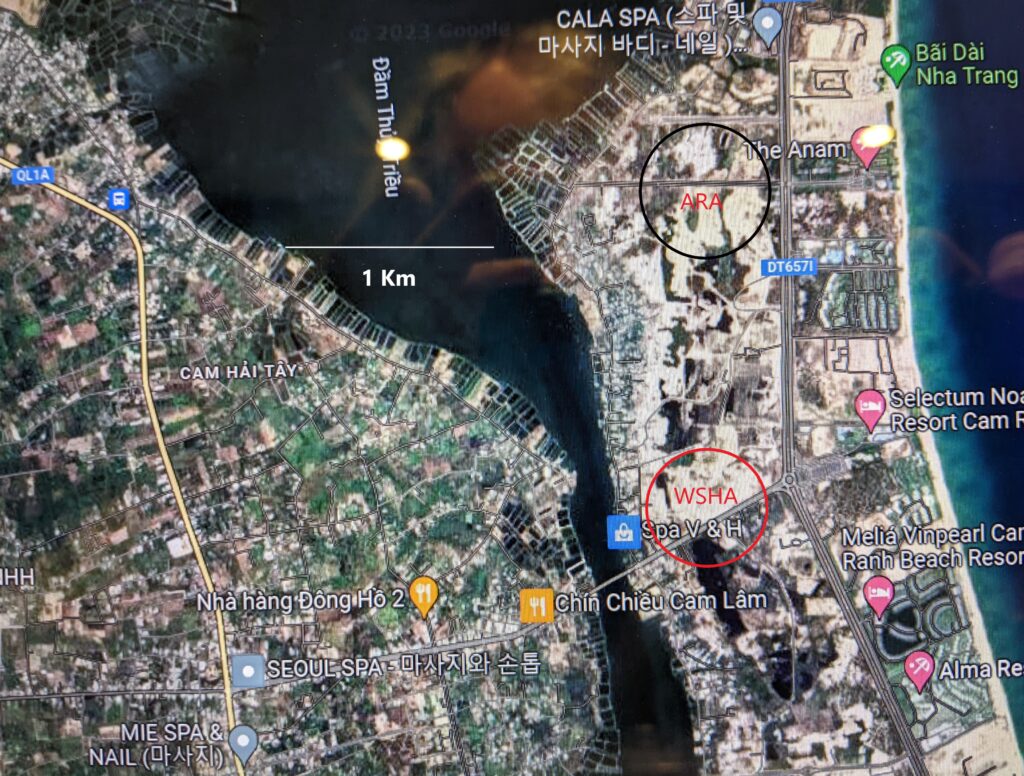
White Sands Hotel Area (WSHA – see preceding map). One survey on 11 November, 2023, 0628-0737 hrs.. This area included a lily lake (about 5 hectares – see following image) adjacent to the roadway, where I spent about fifteen minutes scanning with a binocular. A couple of busy roadside food stalls indicated that birdlife would probably be scarce. Unexpectedly, I found three new species for the trip list, Common Moorhen, Pheasant-tailed Jacana and Black Drongo. A spotting scope would have been useful for scanning the lake.
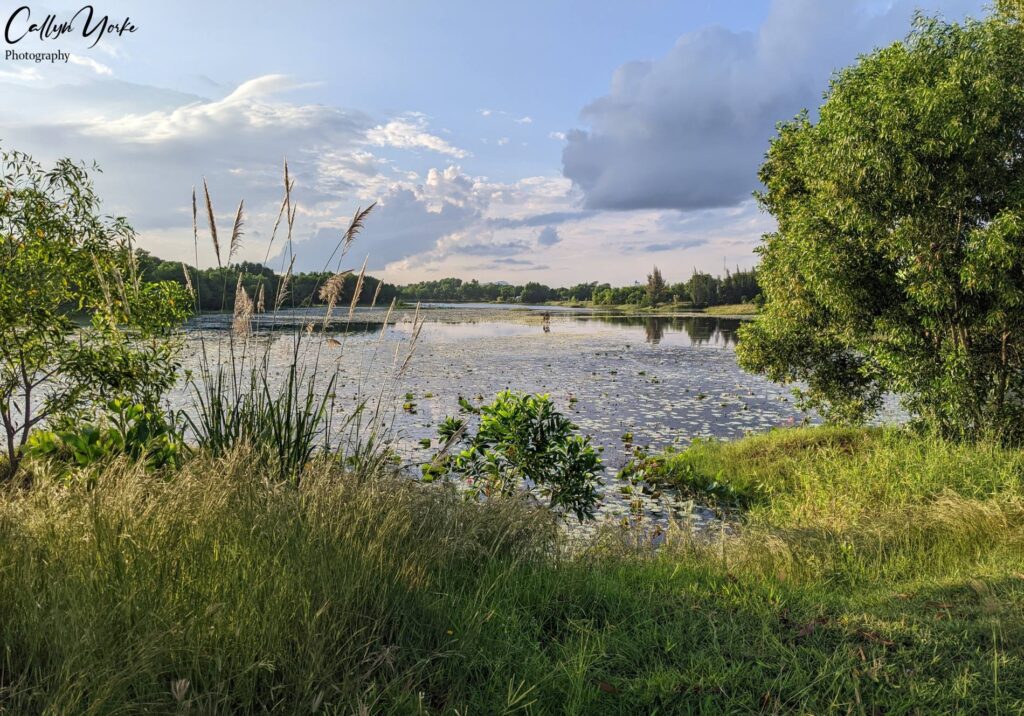
Immediately across the roadway to the north and east, was a large sand mining operation that had left several hectares of coastal dune scrub scarred with excavations filled with rainwater (see following image). I walked around the area for about forty-five minutes and added four new bird species to the trip list: Great Thicknee, Blue-tailed Bee-eater, Long-tailed Shrike and Plain-backed Sparrow.
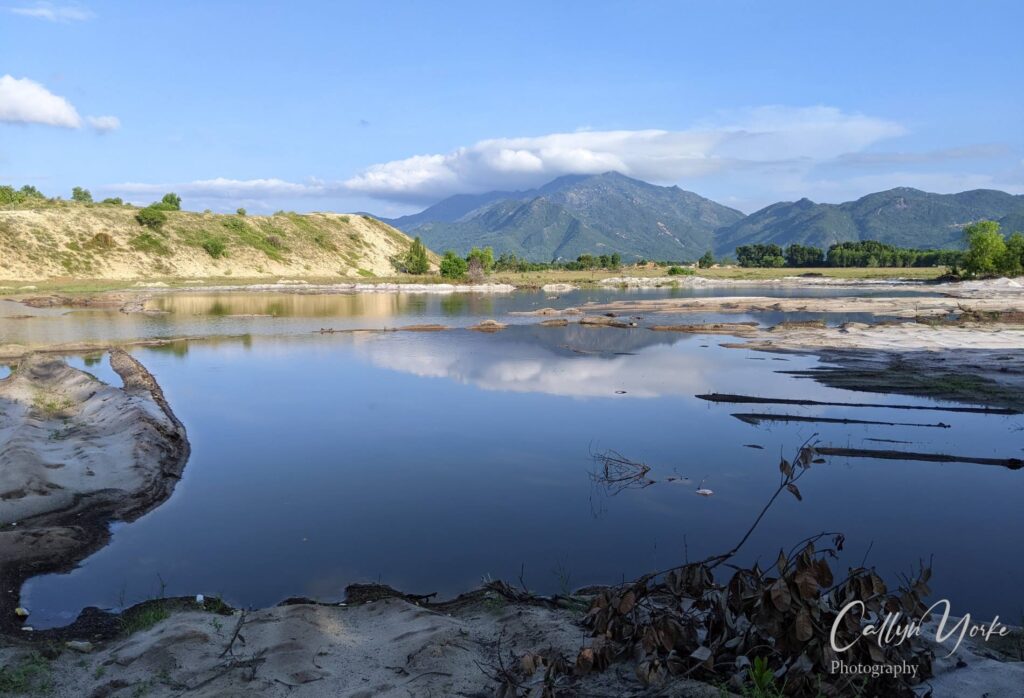
Anam Resort Area (ARA – see above map). One survey on 12 November, 2023, 0615-0740 hrs.. This was a coastal dune scrub area that I had surveyed multiple times during previous visits to CRB (2019 & 2020). Although my previous surveys had produced a fairly high diversity of bird species here (see survey links on the first page of this report), very little birdlife was found during this particular survey. While walking over the dunes, around several lily ponds (old sand excavation pits) and coastal scrub, I found a set of sharpened poles stashed in the shrubbery that were probably part of a bird net set-up. Thus, it appeared this area was being used by poachers, which would have rendered the local birdlife scarce and difficult to observe. No new bird species were added to the trip list here (see following image).
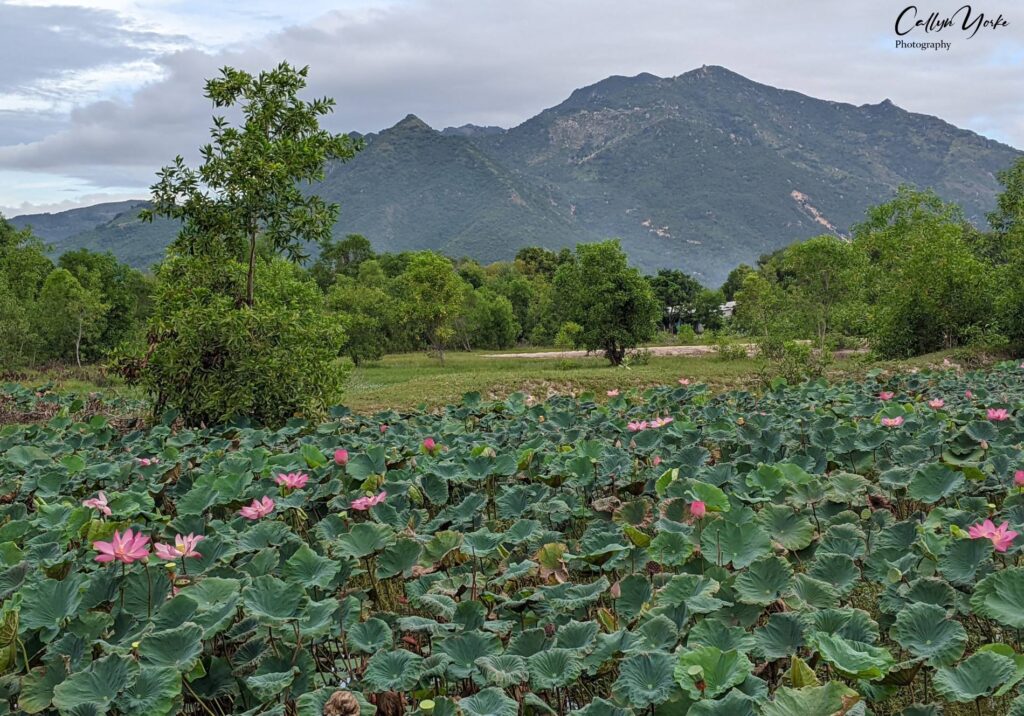
Methods and Materials
All of the areas described above were surveyed on foot, using a Zeiss 10 x 42 binocular and a Nikon D850 camera fitted with a Nikon PF 500mm lens. A Google Pixel 3X cell phone was used to photograph locations and items of interest. Handwritten field notes were made in a pocket notebook and recopied into a loose-leaf binder format each evening. My notes, together with digital images obtained at each site, formed the basis for this report.
Annotated Bird List – Cam Ranh Bay Area – November 8-14 2023 Callyn Yorke
Legend
Abundance: Numbers following each species entry are the highest count for a single survey, when multiple surveys at a particular location were made. Locations (see below) with the highest numerical abundance are listed first in the species accounts.
Age, sex and molt (when known): ad = adult; imm = immature; m = male; f = female; bsc plmg = basic (non-breeding plumage; alt plmg = alternate (breeding) plumage; trans = transitional plumage, e.g. alternate into basic plumage.
Survey Location Abbreviations (see preceeding maps): NH = Navy Hotel grounds; NHEP = Navy Hotel East Ponds; CP = Casuarina Ponds; WSPM = Western Ponds and Marsh; WSHA = White Sand Hotel Area, Bai Dai; ARA = Anam Resort Area, Bai Dai; Ubiq = Ubiquitous in appropriate habitat.
Ecology and Behavior: aerial insect hawking (ah); taking fruit, berries or parts of flowers (fr); gleaning insects from foliage (ig); probing into surface (pr); estimated height (m) above ground (agl); gregarious (greg); mixed-species flock (msf).
Systematics and Nomenclature used herein, is an amalgam of Avibase, International Ornithological Congress (IOC) and current (2023) online resources, i.e. Birds of the World, Cornell University, USA.
Birds Noted
- Muscovy Duck Carina moschata (exotic- domestic) 9 greg. foraging in pasture and adjacent Navy residence, CP.
- Swan Goose Anser cygnoides (exotic – domestic) 5 greg. foraging in pasture and adjacent Navy residence, CP.
- Feral Rock Pigeon Columba livia (exotic – domestic) 3 greg. flying 10m agl over pasture and adjacent residential areas, CP; NH.
- Red Turtle Dove Streptopelia tranquebarica 23 greg. on utility wire early mornings and late afternoons, NH; NHEP.
- Eastern Spotted Dove Spilopelia chinensis 2 pairs flushed from ground, WSPM; 2 ARA.
- Zebra Dove Geopelia striata 6 greg. vocal, often foraging on ground; resting on utility wires, Ubiq.
- Pink-necked Green Pigeon Treron vernans 16 greg. a cohesive flock rapidly circling Acacia trees and alighting in tree canopy, NH.
- Germain’s Swiftlet Aerodramus germani 120 greg. loosely gregarious over large areas; 0.2 – 80m agl, skimming ponds and mudflats at dusk; locally nesting in modified multilevel commercial and residential buildings broadcasting the vocalizations of this species; numerically dominant and probably displacing other swift species throughout the lowlands of Vietnam, Ubiq. (photo).
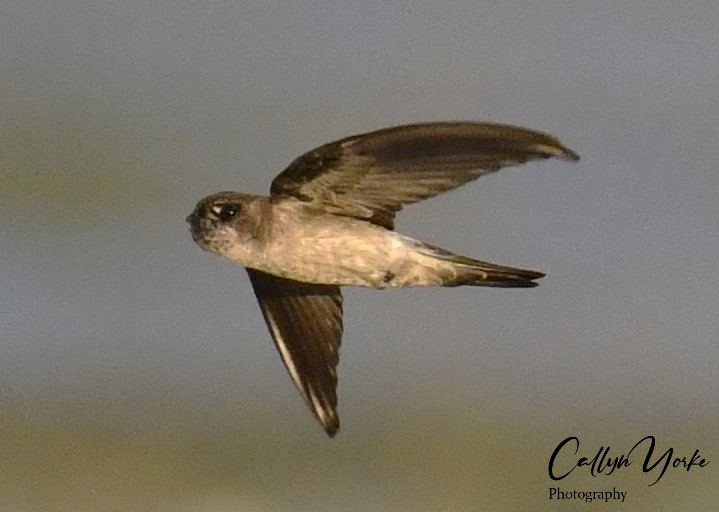
- Asian Palm Swift Cypsiurus balasiensis 1 flying southwest at dusk, 10m agl, over mangrove and roadway, NHEP.
- Greater Coucal Centropus sinensis 2 repeatedly vocal, active in tall, dense coastal scrub and grasses, NH; CP; WSHA; ARA.
- Banded Bay Cuckoo Cacomantis sonneratii 1 vocal (unseen) late afternoon in Acacia and mangrove, NH; NHEP.
- White-breasted Waterhen Amaurornis phoenicurus 1 proceeding cautiously on mudflat at edge of mangrove in late afternoon, NHEP.
- Common Moorhen Gallinula chloropus 3 greg. a pair and separate individual swimming and remaining partly concealed amongst lily pads in lake, WSHA.
- Yellow Bittern Ixyobrychus sinensis 1 (ad) flushed from mangrove; alighting about 20m away in a separate mangrove area, CP.
- Cinnamon Bittern Ixobrychus cinnamomeus 1 (imm) foraging in tall, marshy grass with ECAE, CP.
- Striated Heron Butorides striata 5 (ad, imm. – noted very dark plumage of immature birds, inviting confusion with Black Bittern, especially in flight), individuals readily flushed from pond edges and mangrove, CP; NHEP; WSPM.
- Chinese Pond Heron Ardeola bacchus 8 (ad, imm) Note: in bsc. plmg. this species is difficult to impossible to distinguish from Javan Pond Heron. But based on known range, i.e. JAPH is thought to be limited in distribution further southward in Cochinchina – see Craik & Minh, Birds of Vietnam. 2018. pp. 82-83). Individuals and small flocks found in a wide variety of wetland habitats; NH; NHE; CP; ARA.
- Eastern Cattle Egret Bubulcus coromandus 5 (bsc. plmg.) greg. foraging in wet pasture with cattle and occasionally, INEG, CP; ARA.
- Gray Heron Ardea cinerea 2 individuals in flight over wetlands; in trees at edge of mangrove channel, CP; WSPM.
- Purple Heron Ardea purpurea 1 an individual in flight, about 20m agl, ARA.
- Eastern Great Egret Ardea modesta 2 individuals in flight and at edge of mangrove channel; ponds with relatively deep water; shy and usually in secluded wetlands, away from human activities, NHEP; WSPM.
- Intermediate Egret Ardea intermedia 13 greg. often seen in flight at dusk and dawn, commuting to and from roost sites; foraging in a wide variety of local wetlands, often with grazing cattle, Ubiq.
- Little Egret Egretta garzetta 30 greg. roosting in Acacia trees adjacent to NH and CP ponds, where found foraging daily; observed in a wide variety of local wetlands, Ubiq.
- Great Thicknee Esacus recurvirostris 1 (ad.) in sandy area next to an excavation pond, hesitating while watching me for a few minutes, then running for cover amongst shrubs, WSHA (photo – see Introduction).
- Black-winged Stilt Himantopus himantopus 90 + greg. rather shy and keeping distant from areas with frequent human activities; an extraordinarily large flock found in a pond-marsh near a mangrove channel, WSPM; 18 (ad, imm) greg. foraging in relatively deep water aquaculture ponds, CP (photo – see Introduction).
- Pacific Golden Plover Pluvialis fulva 25 (bsc. plmg.), greg. a large, presumably migratory flock of at least 25 individuals, some flushed from a pasture, others relying on a cryptic-patterned plumage, remaining partly concealed nearby in marginal tall grass, WSPM; elsewhere, individuals, loosely greg. resting in and around aquaculture ponds, HNEP; CP (photo).

- Little Ringed Plover Charadrius dubius (subspecies, jerdoni & curonicus were present, with about equal frequency and abundance, though I did not include separate counts for them) 30 (bsc. (most common), trans. and alt. plmg. (relatively rare)), greg. individuals, pairs and trios on mudflats throughout, sometimes on relatively dry sandflats bordering ponds and wet grassland; this species, presumably including resident and migrant individuals, was the most numerically dominant plover within the survey areas; foraging amongst other plovers and stints, often occurred in the muddy shallows and edges of aquaculture ponds; one individual was observed stirring the pond water with its feet, in a similar fashion as done by herons and egrets, Ubiq. (photo).
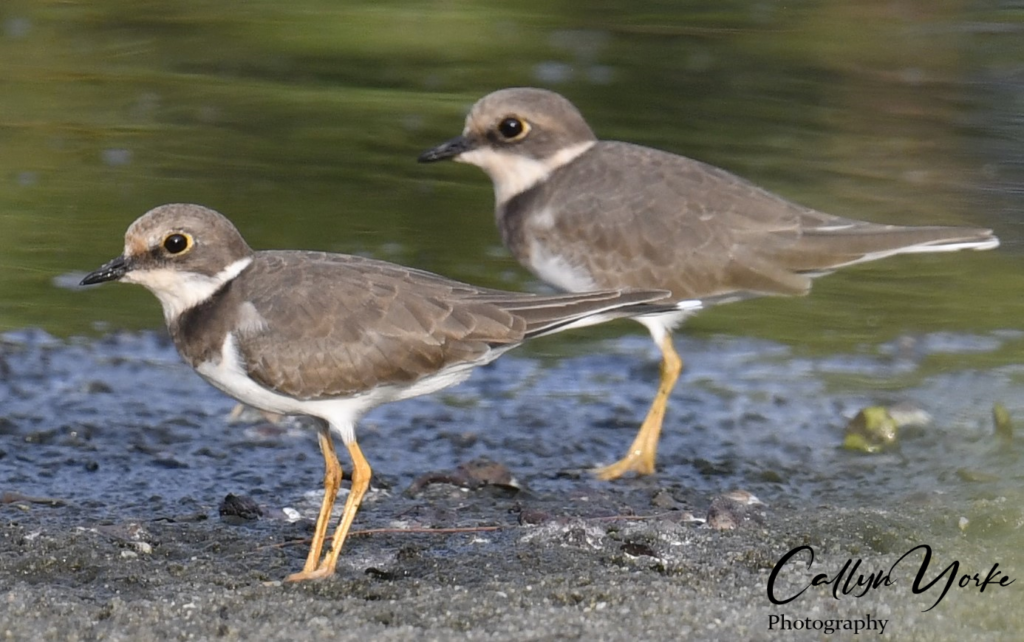
- Kentish Plover Charadrius alexandrinus 8 (bsc. plmg.) judged most numerous and frequent on NHEP; individuals and pairs on mudflats with other plovers and stints, sometimes being aggressively displaced by larger species, e.g. LRPL, NHEP; CP.
- White-faced Plover Charadrius dealbatus 2 on mudflats of ponds in msf with other plovers and stints, but keeping their distance from other birds. Most frequently found on NEHP; once at CP.
- Lesser Sandplover Charadrius atrifrons 20 variably solitary and greg. often found resting at edges of aquaculture ponds at NHEP, where it showed a higher frequency and abundance than at CP; often in msf with other plovers and stints, NHEP; CP (photo).

- Mongolian Sandplover Charadrius mongolus 1 (ID by slightly more robust profile, darker leg color and broad breast side-patch in comparison with nearby LESP), NHE.
- Greater Sandplover Charadrius leschenaultii 35 (bsc. and trans. plmg (rare); largely greg. foraging on mudflats and resting on shallow berms around aquaculture ponds, in msf with other plovers and stints; a numerically dominant plover with LRPL, NHEP, CP (photo – see Introduction).
- Pheasant-tailed Jacana Hydrophasianus chirurgus 1 (ad) seen briefly in a low, short flight over the lake, alighting and remaining partly concealed amongst the water lilies, WSHA.
- Broad-billed Sandpiper Calidris falcinellus 4 greg. pr. deeply in mud substrate of aquaculture pond in msf with RNST and LRPL, NHEP (photo).
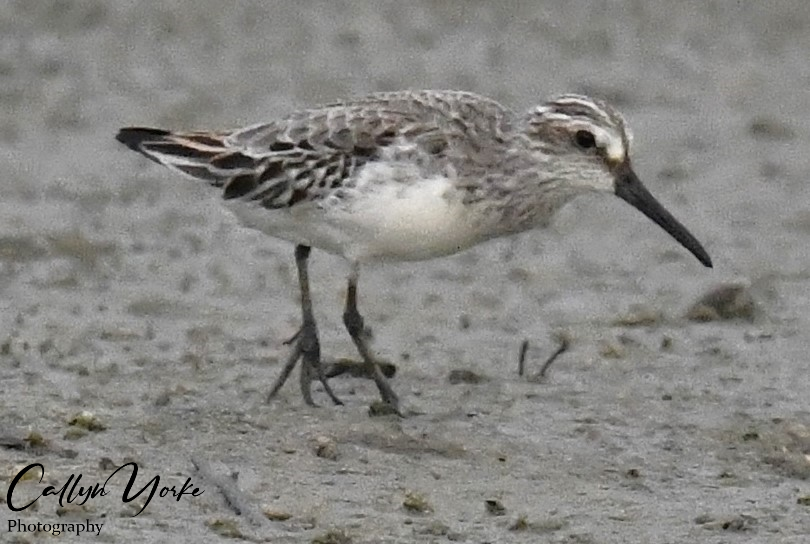
- Long-toed Stint Calidris subminuta 12 greg. pr. shallow and deeply in mud substrates at edges and shallow sections of ponds, usually (but not always) near vegetation, e.g. pickleweed, saltgrass or regenerating mangrove, CP; NHEP; WSPM.
- Red-necked Stint Calidris ruficollis 80 greg. pairs and small flocks foraging continuously on mud substrates, less commonly in shallows; often in msf with small plovers. Numerically, the dominant Calidris sp. in the partially inundated aquaculture ponds, NHEP; CP.
- Common Snipe Gallinago gallinago 2 (ID based on visible white edges of secondaries) pairs, often vocal when flushed from regenerating mangrove; one individual pr. in shallow tidal rivulet at the base of mangrove NHEP; most often encountered at CP (photo).
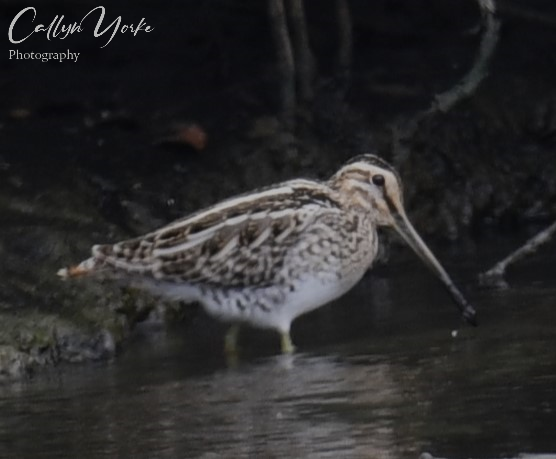
- Common Sandpiper Actitis hypoleucos 2 individuals pr. and running at edge of ponds and mangrove, shy, avoiding areas with human activities, usually not associating with other birds, Ubiq.
- Common Greenshank Tringa nebularia 14 (bsc, plmg.) greg. edges and shallows of large pond and marsh, WSPM.
- Common Redshank Tringa totanus 1 (bsc. plmg.) resting then foraging in shallows, NHEP (photo).
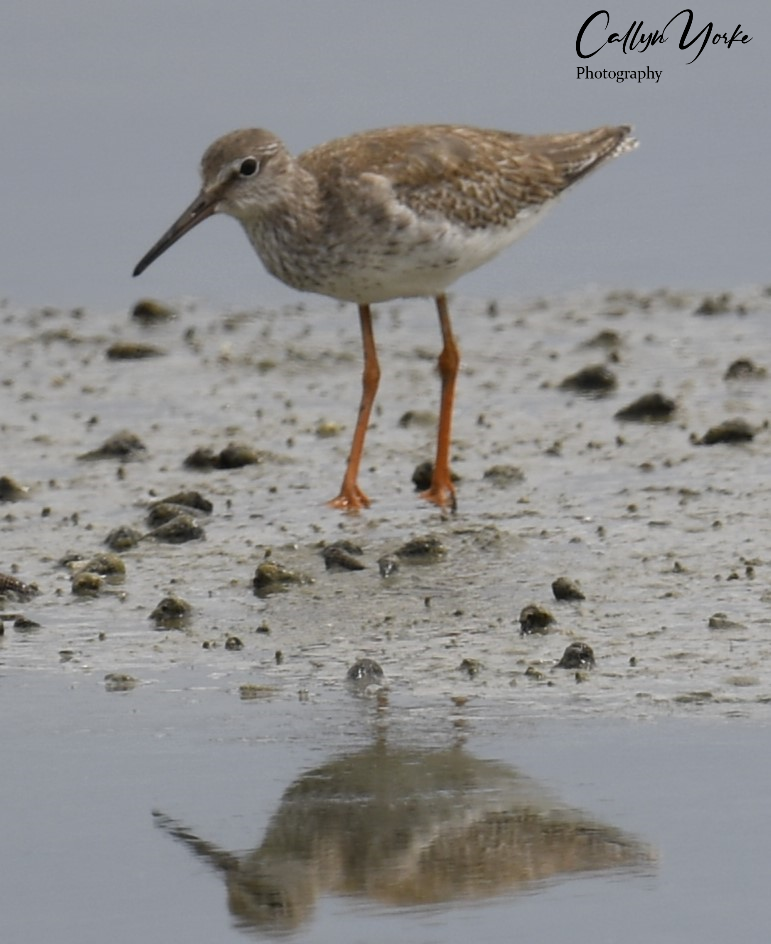
- Wood Sandpiper Tringa glareola 6 (bsc. plmg.) individuals resting and pairs at edge of ponds and in marsh, mangrove, CP; WSPM.
- Marsh Sandpiper Tringa stagnatilis 25 (bsc. plmg.) greg. foraging busily in shallows, CP; NHEP.
- Asian Green Bee-eater Merops orientalis 8 greg. sallying for large insects from shrubs, low tree limbs and utility lines, to ground, shrubs and marsh, CP; WSHA, ARA.
- Blue-tailed Bee-eater Merops philippinus 9 vocal, greg. aerial sallies from trees at edge of ponds and clearings, WSHA; ARA (photo).
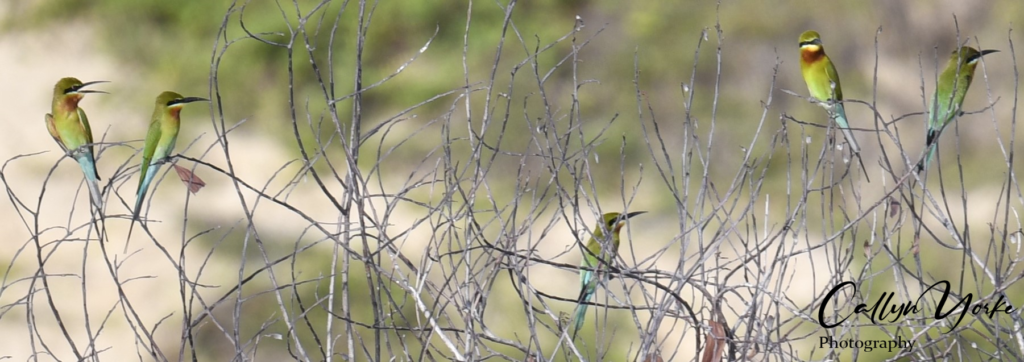
- Common Kingfisher Alcedo atthis 1 low perch in mangrove edge, NHEP.
- White-breasted Kingfisher Halcyon smyrnensis 3 vocal perched 2-3m agl on posts and trees in and around of ponds and clearings, ARA; WSPM; WSHA.
- Black Drongo Dicrurus macrocercus 2 a pair perched on adjacent posts in the lily lake; one flying low at edge of pond and wooded lot, WSHA; ARA.
- Northern Brown Shrike Lanius cristatus 1 on utility wire at edge of mangrove clearing, CP.
- Burmese Shrike Lanius collurioides 3 individuals trees and tall shrubs at edge of clearings and ponds, ARA; CP; WSHA.
- Chinese Long-tailed Shrike Lanius schach 1 perched 4m agl in isolated tree next to a pond and open field, WSHA.
- Double Zitting Cisticola Cisticola tinnabulans 2 vocal and active low in shrubs at edge of pasture, WSPM.
- Plain Prinia Prinia inornata 5 vocal, active, though secretive in mangrove and tall shrubs at edges of clearings and ponds, Ubiq.
- Common Tailorbird Orthotomus sutorius 2 vocal and active, though secretive in Acacia trees and tall shrubs, NH.
- Oriental Reed Warbler Acrocephalus orientalis 16 highly vocal, active, though secretive in shrubs at edges of clearings and mangrove, WSPM; CP; NHEP.
- Eurasian Barn Swallow Hirundo rustica 18 greg. flying low, back and forth over a wide variety of wetlands, often in msf with GESW; most abundant and conspicuous before and after rains, Ubiq (photo).
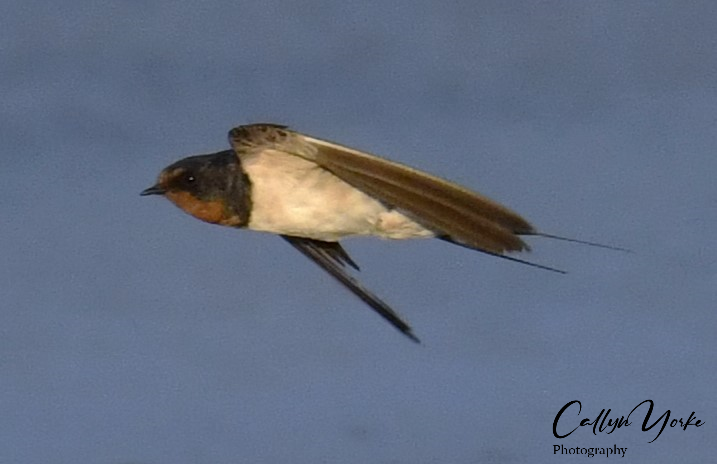
- Southern Sooty-headed Bulbul Pycnonotus aurigaster 2 a pair on a utility wire at the edge of the mangrove, approached and closely watched by a SEBU, CP.
- Streak-eared Bulbul Pycnonotus conradi 5 vocal, greg. in mangrove and Acacia trees, CP; NH; ARA.
- White-shouldered Starling Sturnia sinensis 25 (ad, imm) vocal, greg. a large flock on utility wires and adjacent trees at edge of mangrove tidal channel, WSPM.
- Common Myna Acridotheres tristis 3 vocal, foraging on refuse in town on streets and in pastures, Ubiq.
- Indian Sparrow Passer indicus 40 (m,f) vocal, greg. on buildings, in yards, pastures; sympatric with EUTS but seldom seen with that species; apparently very locally distributed in the CRB area, CP.
- Eurasian Tree Sparrow Passer montanus 20 (m,f) vocal, greg. on buildings and in trees, pastures, streets; numerically dominant to and more widely distributed than INSP, Ubiq.
- Plain-backed Sparrow Passer flaveolus 5 (m,f) greg. a flock perched in an isolated tall tree at the edge of a large field, WSHA.
- Paddyfield Pipit Anthus rufulus 12 loosely greg. in pasture, edges of aquaculture ponds, pathways, fairly confiding, Ubiq (photo).
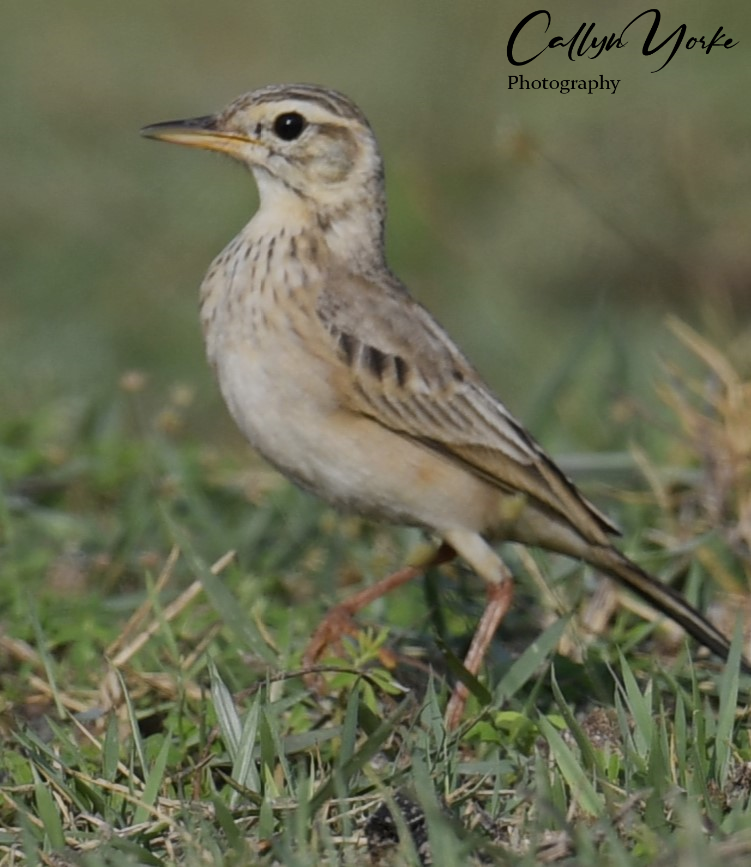
- Eastern Yellow Wagtail Motacilla tschutschensis 5 individuals and pairs, highly active on the ground, in and around aquaculture ponds, pasture and open, wet ground, CP; NHEP; WSPM.
_______________________________________________________________________________________
Cam Ranh, Khánh Hòa Province, Vietnam: 3 -12 July 2019
Callyn Yorke
Seldom visited by ornithologists, the Cam Ranh Bay area had been on my list of travel destinations since my arrival in Vietnam in 2017. Conveniently, Cam Ranh, located on the southeast coast of Vietnam, between Phan Rang and Nha Trang, is easily reached in three hours by car from DaLat. A close inspection of satellite images on Google Maps, showed what appeared to be a significant amount of natural vegetation and potential habitat for birds and other wildlife. The weather in July is typically hot and relatively dry, similar to what I am accustomed to in Southern California. Although mid-summer isn’t an optimal time for avian diversity and abundance (waterbird migration is minimal until August & September), early morning birding in coastal dune scrub can be productive.


For a ten-day visit, I chose one of the swankiest, five-star resorts in the entire country. My Vietnamese birder-girlfriend Dạ Thảo, was alarmed, though not enough to argue convincingly for more affordable accommodations. We had traveled the length of Vietnam together, sampling a range of hotels from roach infested hostels to beach front high-rises, The Anam Resort, located on the picturesque Bãi Dài beach, seemed suitable to me, aside from the price ($300 per day – a decent monthly wage in Vietnam). Traveler reviews were largely excellent. Rooms had wifi and natural habitat was within walking distance; surfboard rental was another plus. Regarding the last item, I was hopeful that there was something left of the surfing season, which normally extends from September to April. On that account, I was flat out of luck. The board rental shop was closed for the season. No worries. I surmised correctly, as it turned out, there would be enough birding and photographic possibilities to keep me occupied for ten days.

I would be mostly on my own until Dạ Thảo returned from a birding trip in Korea to join me on July 7. Fortunately, folks at the Anam spoke English (several of the staff were polyglots) and assisted me with information about the local geography. Outside of the resort, English is scarcely spoken or understood. This is true for most of Vietnam.
Immediately following check-in, I walked out to the beach and noticed a single set of relatively fresh shorebird tracks. I followed the tracks back into a patch of coastal dune scrub in an undeveloped lot adjacent to the resort. There was no further sign of the owner.

The tracks were clearly made by a medium to large-sized shorebird with three large, well-separated toes pointing forward (anisodactyl). Could those tracks belong to a Great Thicknee? Wow! That would be something – a Vietnamese rarity and a life bird practically living at the resort. But since thicknees are usually nocturnal, I would be unlikely to see one until after dark. Best to come back to this spot later in the evening, or perhaps just before sunrise.
After a somewhat bland Vietnamese version of vegetarian pizza, I was ready to put on my headlamp and go for a stroll on the beach. The air temperature was hovering in the low 30C range. Gentle onshore breezes rustled the palms with an incoming tide. Old wooden fishing boats punctuated the horizon. A very romantic setting, for sure. But I was still a little uneasy in paradise. This cornucopia had a price tag.

For starters, I was mildly surprised to be reminded by the pizza bill, that only breakfast was included in the daily resort fee. Subsequently, I was disappointed by the high cost of a mediocre lunch and dinner, averaging about $25 each. Tiger Beer ($2) was the best deal at three, foreign-themed restaurants. I didn’t recall those concerns being mentioned in the traveler reviews. Perhaps I should have read them more carefully. After about a week it became clear why the majority of Anam Resort guests stayed only three or fewer days. They probably didn’t want their homes foreclosed while they were out living it up.
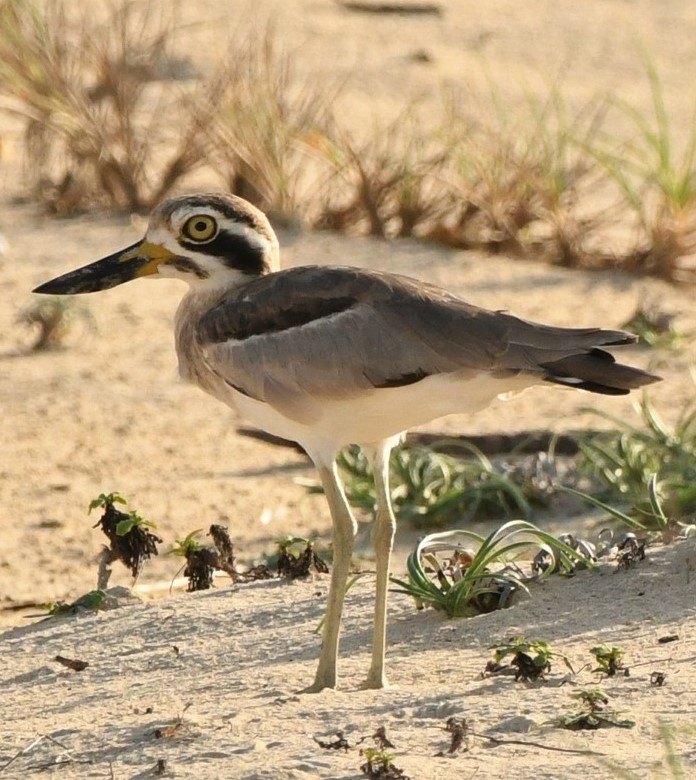
After about twenty minutes of searching the beach and edge of the coastal dune scrub for the avian owner of the mystery tracks, no luck. But when I showed a security guard an image of a Great Thicknee on my cell phone, he immediately nodded and pointed toward the beach. He indicated that he knew their sounds as well. His beach guard post, a wooden shack with only door and window frames, was actually a convenient bird blind. He flipped through my field guide (Birds of Vietnam, 2018 by Craik & Minh) and pointed to birds of the area he recognized.

Just then, a nightjar flew in low and circled the shack. Two or three more nightjars showed up, landing nearby in the dune scrub. My head was spinning. There were a couple of possibilities, i.e. Indian Nightjar and Franklin’s Nightjar, both potential lifers. But neither of us could see the birds well enough to be sure of their identities. Already, there were intriguing prospects for birding around the resort. I could scarcely get any sleep that night, waking up repeatedly, afraid of missing a fresh start before daybreak. I had no idea how to set the alarm clock on the nightstand and I was too exhausted to fight with it.
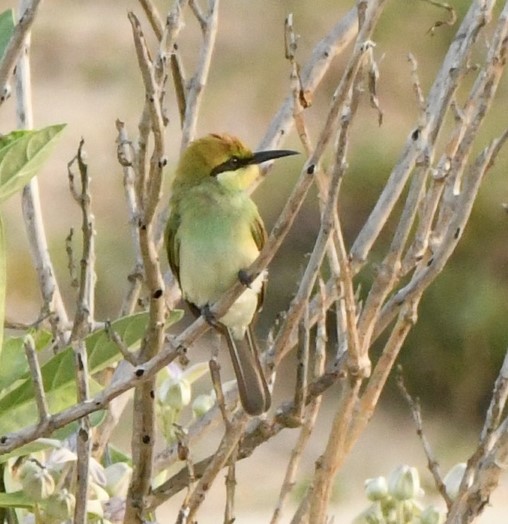
Sunrise on Bai Dai beach had a dreamy, inspirational quality, one that awakens the possibility of being filled with enough joy and energy for a lifetime. The increasingly intense, orange-red sky beckons people like iron filings to a magnet. Each morning before daybreak, hundreds of Vietnamese – villagers, construction workers, hotel staff, businessmen, government officials and a few foreigners, celebrate the sunrise by gathering on Bai Dai beach, dancing, dipping into the warm surf, jogging the tide line, performing hilarious calisthenics; everyone actively participating in the renewal of life; the miracle of a new day. The first morning I witnessed this spectacle, I knew I had come to a very special place. There is nothing in the world comparable to a Vietnamese coastal sunrise. Then again, there is no place quite like Vietnam.

Unlike the Vietnamese, most shorebirds avoided the beach altogether. If there were any birds utilizing this stretch of the beach, they had moved somewhere else by sunrise, probably to a secluded spot with fewer people (I had little idea where that might be; the beach is fronted by hotels, resorts and construction projects for several kilometers). The dunes behind the beach in a hotel construction zone offered the most convenient retreat. That was where I soon came upon a pair of Great Thicknee, about 20 m away, staring back at me with large yellow eyes. Incredible. There was just enough early morning light for photos. I fired off a series of shots with a Nikon D850 and 200-500 mm lens. The pair tolerated my presence for a few minutes, separated, then ran a short distance before making a brief flight to cover. When I found their fresh tracks in the sand, I captured some images with a Google Pixel 3X cell phone. The tracks matched the ones I had seen on the beach the previous day. Yes! This discovery, though admittedly rather trivial for all but a handful of scientists, was an “ah-hah” moment. More often, I search diligently in the correct habitat at the correct season for special birds, only come away empty handed. In this case, what little published information I had found on the status and distribution of Great Thicknee, indicated the species was very rare in Vietnam. Indeed, local extirpation of the Great Thicknee could definitely become a reality unless habitat conservation measures are implemented very soon.

Following the discovery of Great Thicknee only a few steps from the resort boundary (daily sightings of as many as four individuals were made thereafter), I began exploring the coastal dune scrub along a road through an abandoned development across the highway from the Annam Resort. This area, of perhaps 100 hectares, consisted of dunes (5-20 m in height), water-filled excavations of various sizes (some, aquaculture ponds; others, abandoned sand quarries), mudflats, cattle pasture, scattered deciduous trees (including exotic plantings, e.g. eucalyptus) and patches of tall shrubs, collectively referred to as coastal dune scrub. The soils were predominately a powdery, white, apparently coral-based sand (i.e., processed by the digestive systems of ancient parrot-fish), which was being mined by local villagers at one location adjacent to a very large, water-filled pit. This luxuriously soft sand, sold by the pound in Western pet stores, makes an excellent substrate for captive reptiles, particularly burrowing forms. The entire area, appearing to be ideal habitat for lizards and snakes, was dissected by unpaved roads and foot paths, providing easy access for exploration. A small number of makeshift huts bordered the site near the highway and a larger, similar settlement occurred about 1 km to the west. Fairly constant but light traffic (mostly motorbikes) occurred on the paved road between those two points. Best of all, I could walk through the uninhabited land each morning without any disturbances, e.g. barking dogs and stares from local villagers. This area turned out to be a remarkably productive area for insects and birds. However, sign of larger animals, e.g. native mammals, was conspicuously absent.

Near the end of one of my morning surveys, as the ambient air temperature approached the high 30’s, I came across a handsome, smooth-scaled lizard, basking on the ground. I recognized it as as Leiolepis sp., which I had observed in Kuala Dungun (on the northeast coast of Peninsular Malaysia) when assigned to the National University of Malaysia as a Biology lecturer (1977-80). Leiolepis sp, obviously tolerant of high temperatures, is similar in some respects to both the Desert Iguana (Dipsosauris dorsalis) and Whiptails (Aspidoscelis spp.) of the Southwestern U.S. and Mexico; Leiolepis, though taxonomically unrelated to iguanas and whiptails, and separated by the Pacific Ocean, may represent what is known as convergent or parallel evolution, i.e. a similar form and adaptation for similar environments (see photos).

The Cam Ranh Leiolepis lizard was fully exposed to the blazing sun and unmoved by my photographic imposition. I was easily able to obtain several close-ups with a DSLR camera and cell phone. The fine resolution of the digital images (up to 45 megapixels with a Nikon D850), provided an opportunity to study the lizard’s scale pattern and other important features for identification.
Later that morning I went online to see if the lizard’s specific identity could be determined. It was my lucky day. This lizard was referable to published descriptions and images of Leiolepis guentherpetersi, one of four closely related endemic species in the region. But there was something else I learned about the Leiolepis lizards that was absolutely fascinating. Most notably, L. guentherpetersi had been found to be uniparental (females only). Furthermore, biologists working on this group of lizards in central-coastal Vietnam during early 1990’s, discovered that some species of Leiolepis had triploid karyotypes, i.e. an extra set of chromosomes (normally there are two sets, one haploid set of homologous chromosomes from each parental gamete, forming an individual- initially called a zygote- with a diploid karyotype). Parthenogenetic reproduction is positively correlated with this anomaly, generally called polyploidy, which is common in plants but rare in animals. Triploid individuals are genetically incompatible with normal diploids, and thus may evolve inbred, reproductively isolated populations, i.e. distinct species.
Scientists are perennially curious folks. They were the kids who wouldn’t stop with ‘why’ questions of their parents; the geeks who read every obtainable book about the captive reptiles on their bedroom shelf. The girls and boys with thick-rimmed glasses who spent hours building model airplanes, testing the tensile strength of water balloons, sketching weird looking animals, making an insect or plant collection for a merit badge, or who wandered off into the woods alone hunting salamanders while their classmates played football. Learning by careful observation and study became a life-long passion, often rising to an almost comical obsession. Strange things are the nutritional staples of a scientist’s intellectual diet. Rarities and oddities demand scrutiny.

For instance, several related questions about parthenogenetic reproduction in Leiolepis lizards come to mind. First, what behavioral and ecological features do these four parthenogenetic species of lizard share in common? What may have been the selective pressures on their ancestors resulting in such deviant reproductive biology? Do the current ranges of any of those species overlap? Regarding the last question, if I had identified this lizard correctly as L. guentherpetersi, a species known thus far only from the central coast of Vietnam around Hoi An, then its range had just extended southward by 500 km. Or, perhaps the Cam Ranh population represents yet another undescribed species (Leiolepis baidaii ?) in Vietnam. The answers to these provocative questions apparently remain unknown and await further research. Vietnam has become famous in recent years as one of the last frontiers in Southeast Asia for scientific discoveries in natural history. No fewer than fifteen new species of lizard have been described for Vietnam since the early 1990’s (Sterling, Hurley & Minh, 2006. Vietnam: A Natural History, Yale Univ. Press.). Nearly everywhere I have looked in Vietnam there has been something new and interesting to investigate.

And, speaking of intellectual nutrition, people in the Ninh Thuan province of south-central Vietnam claim that Leiolepis lizards should be included in a healthy diet. These lizards, considered a delicacy, are reported to fetch a high price in local markets. Pardon the pun, but I suppose Vietnamese conservationists might find that reptilian culinary tradition rather difficult to swallow.
Early morning (0530-0740 hrs.) in Cam Ranh was definitely the best time for birding. Three hours after sunrise the heat became intense (32 to 37 C) and bird activity declined dramatically. Walking essentially the same route through the coastal scrub on ten successive days, allowed me to learn something about the habits of common resident species, e.g. Red Turtle Dove, Black-necked Lapwing, Great Thicknee, Cinnamon Bittern, Asian Green Bee-eater, Blue-throated Bee-eater, Eurasian Hoopoe, Black Drongo, Streak-eared Bulbul, Yellow-bellied Prinia, Ornate Sunbird, Paddyfield Pipit and Indochinese Bushlark. Less common species, such as White-browed Crake, Barred Buttonquail, Little Tern and Striated Heron, seen only once or twice during my surveys, usually brought the morning tally to an average of thirty species, plus or minus two.
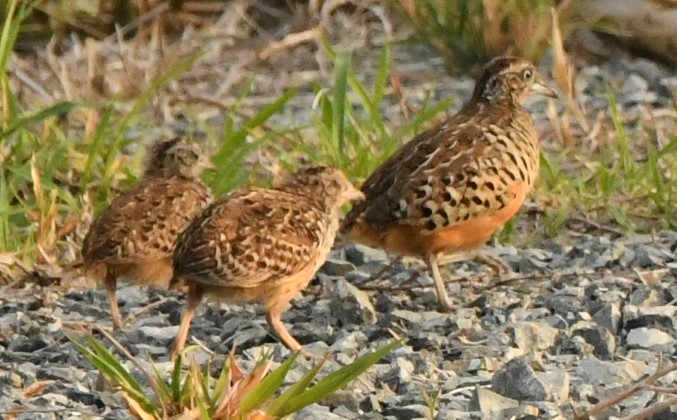
There were a few delightful surprises during the routine surveys, including a stunning pair of Painted Snipe (a lifer for Da Thao and I), initially concealed among snags at the edge of a mudflat. An odd reversal of sexual dimorphism occurs in this species (also in Barred Buttonquail – see photos); females have noticeably brighter plumage than males. Such dimorphism is rare in birds and is often accompanied by a reversal in the usual sex roles. Males, rather than females, invest a disproportionate amount time incubating eggs and caring for the young. Meanwhile, females may be busy seeking other mates (polyandrous). The selective pressures favoring the evolution of this phenomenon are mostly a matter of speculation among behavioral ecologists. Turning to our Anthropology colleagues for help, we might ask if the tendency of women to adorn themselves with ornate clothes and cosmetics, is not arguably another example of reversed sexual dimorphism.
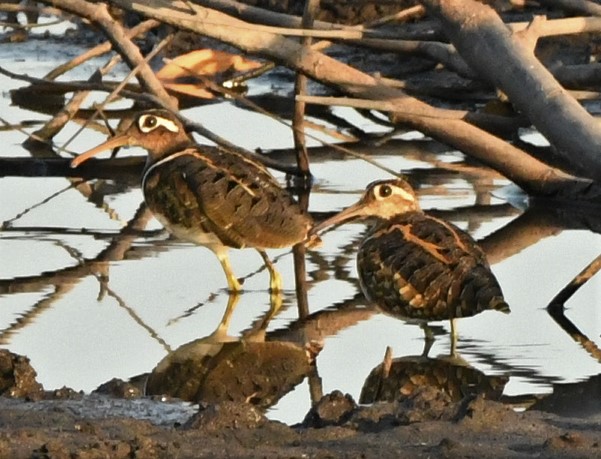
Toward the end of our stay in Cam Ranh, a couple of migrants showed up in the survey area: Asian Emerald Cuckoo and Little Ringed Plover. The provenance of these two individuals was unknown. Little Ringed Plover breeds in extreme South Vietnam, which could possibly include the Cam Ranh Bay area. Northward post-breeding dispersal may be expected for this species. The opposite applies to Asian Emerald Cuckoo, breeding mainly in the north, extending to south-central Vietnam (presumably north of Cam Ranh Bay) and migrating south for the winter. Most likely, this area contains a mixed assemblage of local and long-distance migrants. My prediction is that many more migratory birds should be found in this area during autumn, winter and spring months. Mudflats and ponds, in particular, should be very attractive to shorebirds.
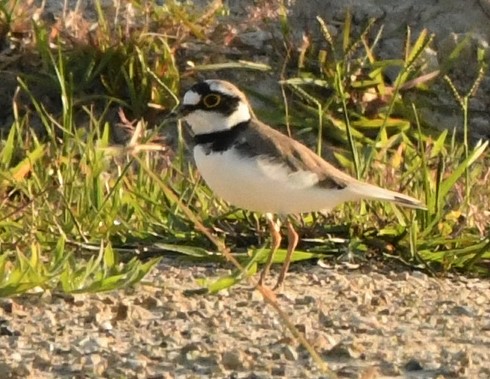

The final tally of bird species found in and adjacent to the Annam Resort between 3 and 12 July (ten surveys, plus casual observations around the resort), was fifty-two, representing twelve orders and thirty-one families. Unrepresented groups of birds included, birds of prey (eagles, hawks, kites & falcons), owls, woodpeckers, barbets, pittas, warblers, babblers, laughingthrushes and flycatchers. However, some birds in those groups may have been present but overlooked. The following is an annotated list of the birds that were observed and identified.

Annotated List Of Birds Found In Bãi Dài, Cam Ranh 3-12 July, 2019 Callyn Yorke
Key
Numbers, 1, 2, 3, following each taxon indicate the maximum number of individuals found during any of the ten surveys. Frequency: Seen on all or most of the surveys (C); Seen on half or fewer surveys (U); Seen on only one or two surveys (R). Coastal Scrub in the vicinity of Bãi Dài Beach (CS), Gardens, ornamental shrubs, trees and lawns in the Annam Resort (G); Outer shore of Bãi Dài Beach (OS); Sex (if known) Male (m), Female (f); Age (if known) Adult (ad), Immature (imm).
Locations: As noted above: Anam Resort, comprised of gardens and mowed lawns, including ornamental flowering trees (Eucalyptus sp.), shrubs and vines, e.g. Bougainvillea. Elsewhwere, a mosaic of coastal scrub and exotic Acacia trees bordered construction zones on the north side and west sides of the resort. Similar habitat was on the west side of the coast highway, in addition to rainwater excavation pits and lily ponds, marsh and pasture (see above photos). All of the above areas surveyed on foot.
Survey Dates: July 3-12 : Ten, two to three-hour morning surveys
Weather: mostly fair to partly cloudy; 28C to 35C; occasional intermittent, light rain; winds ranging from calm to light breezes.
Time: 0520-0830 hrs.; occasionally mid day and late evening.
Observers: C. Yorke and D.T. L. Nguyen.
BIRDS NOTED (Taxonomy largely follows Birdlife International 2018)
- Lesser Whistling Duck (Dendrocygna javanica) 4 gregarious, wary and readily flushed; in larger ponds (U).
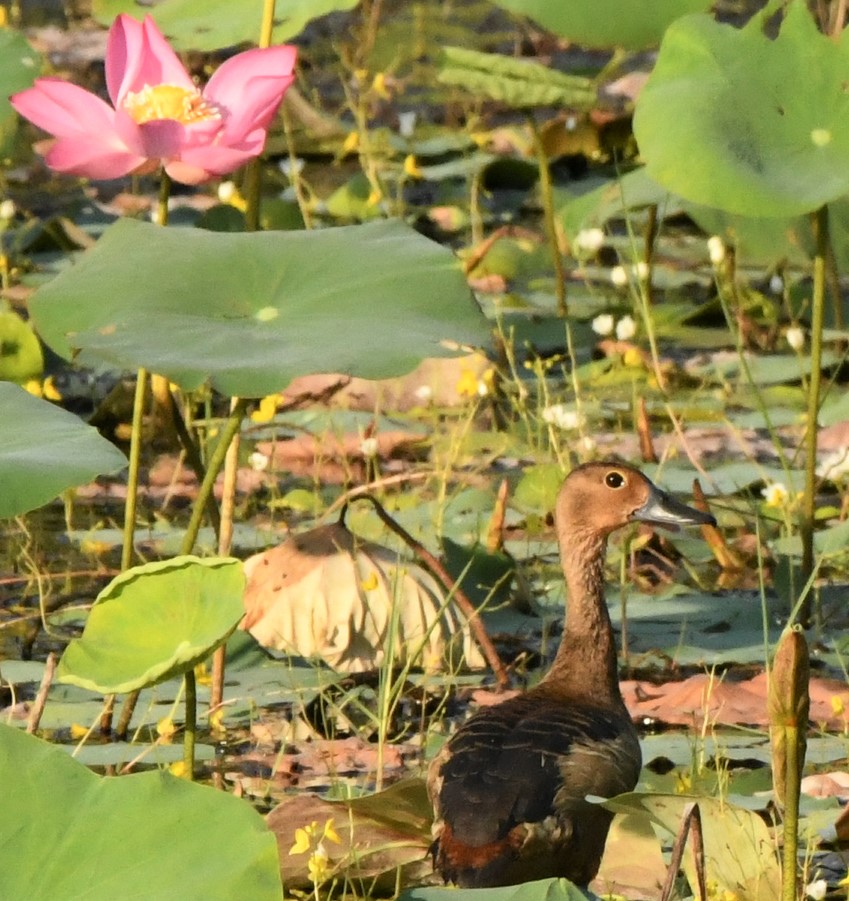
- Little Grebe (Tachybaptus ruficollis) 1 diving in the largest water-filled excavation (R).
- Red Turtle Dove (Streptopelia tranquebarica) 20 gregarious, often roosting in tallest trees outside the resort (C).

- Eastern Spotted Dove (Spilopelia chinensis) 1 on roof at resort (R).
- Zebra Dove (Geopelia striata) 10 gregarious, vocal, often in pairs on ground in coastal scrub (C).
- Indian Nightjar (Caprimulgus asiaticus) gregarious, often paired; flushed at about 3m from daytime roosts (relying on cryptic plumage but changing daytime roost sites when disturbed) while on the ground in coastal scrub adjacent to the resort; active in CS near the beach at dusk (C).

- Germain’s Swiftlet (Aerodramus germani) 30 gregarious, flying at heights ranging from 2 – 80 m, depending on cloud cover (lowest when overcast and/or raining) ubiquitous (C).
- Asian Palm Swift (Cypsiurus balasiensis) 10 gregarious, ubiquitous, flying at heights ranging from 1 – 20m (C).
- House Swift (Apus nipalensis) 1 flying over CS at about 80m (R).
- Greater Coucal (Centropus sinensis) 2 vocal in trees, CS (C).
- Asian Emerald Cuckoo (Chrysococcyx maculatus) 1 in small tree at the edge of a lotus pond, CS (R).
- Plaintive Cuckoo (Cacomantis merulinus) 1 repeatedly vocal, remaining concealed in tree foliage, CS (C).
- White-browed Crake (Amaurornis cinerea) 1 shy and retiring in lotus pond, CS (R).
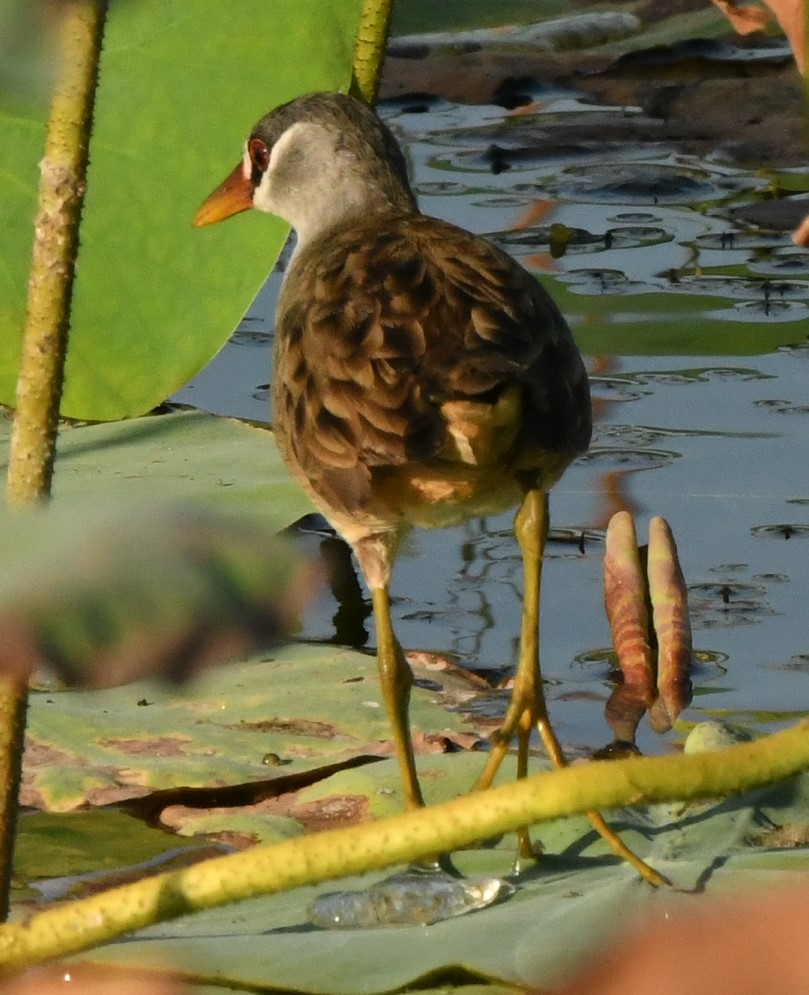
- Common Moorhen (Gallinula chloropus) 1 flushed at edge of lotus pond, CS (R).
- Yellow Bittern (Ixobrychus sinensis) 1 flushed from edge of lotus pond, CS (R).
- Cinnamon Bittern (Ixobrychus cinnamomeus) 3 edge of well vegetated ponds, readily flushed, fl CS (C).

- Striated Heron (Butorides striata) 1 perched on a limb over a pond, wary and readily flushed, CS (R).

- Chinese Pond Heron (Ardeola bacchus) 2 edge of ponds, pasture, CS (C).
- Intermediate Egret (Ardea intermedia) 1 in flight over CS, (R).
- Little Egret (Egretta garzetta) 1 on mudflats, flying to top of a tree, CS (R).
- Little Cormorant (Microcarbo niger) 2 perched on snags in largest pond, CS (C).
- Great Thicknee (Esacus recurvirostris) 4 individuals and pairs, usually in open, sandy areas, e.g. top of dunes, clearings around ponds, disturbed vegetation bordering construction zones; wary, but tolerant of human presence to a distance of 20-30 m; predominately cursorial and reluctant to fly; active at night and for about an hour after sunrise; no vocalizations heard, CS, OS (C).

- Little Ringed Plover (Charadrius dubius) 2 gregarious, ad (alt. plmg.) and imm., edge of pasture and pond, CS (R – 12/7/2019).
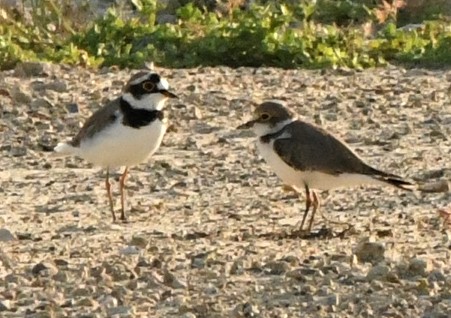
- Malay Plover (Charadrius peronii) 1 imm foraging at the tideline, frequently flushed by people on beach; retreating to undisturbed areas on the beach, and edges of ponds, active at midday on beach, OS, CS (C).
- Black-necked Lapwing (Vanellus atronuchalis) 4 individuals and pairs, highly vocal, especially in flight when disturbed; often circling above as I walked through the area, CS, AR (C).

- Greater Painted Snipe (Rostratula benghalensis) 3 (m,f) gregarious, a pair and trio at edge of mudflat, wary, readily flushed and usually staying concealed but occasionally walking out on an open mudflat, CS (R).
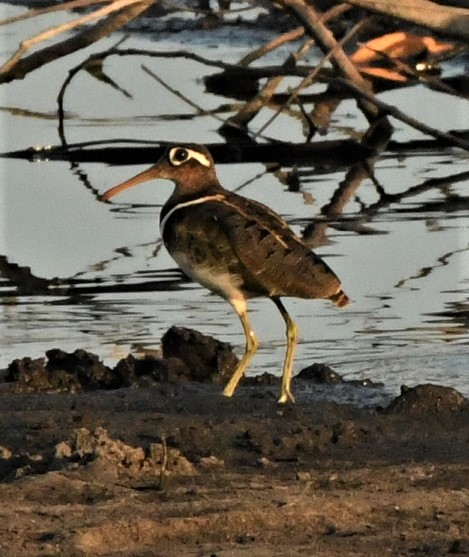
- Barred Buttonquail (Turnix suscitator) 3 (1 adult m and 2 imm), wary, gregarious, walking quickly across driveway into a disturbed, brushy area bordering a construction zone, CS (R).
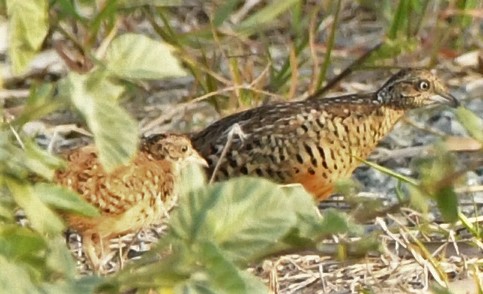
- Little Tern (Sterna albifrons) 1 ad flying over and repeatedly circling largest ponds, CS (R).
- Eurasian Hoopoe (Upupa epops) 5 individuals on ground beneath large trees; readily flushed to cover, CS (C).
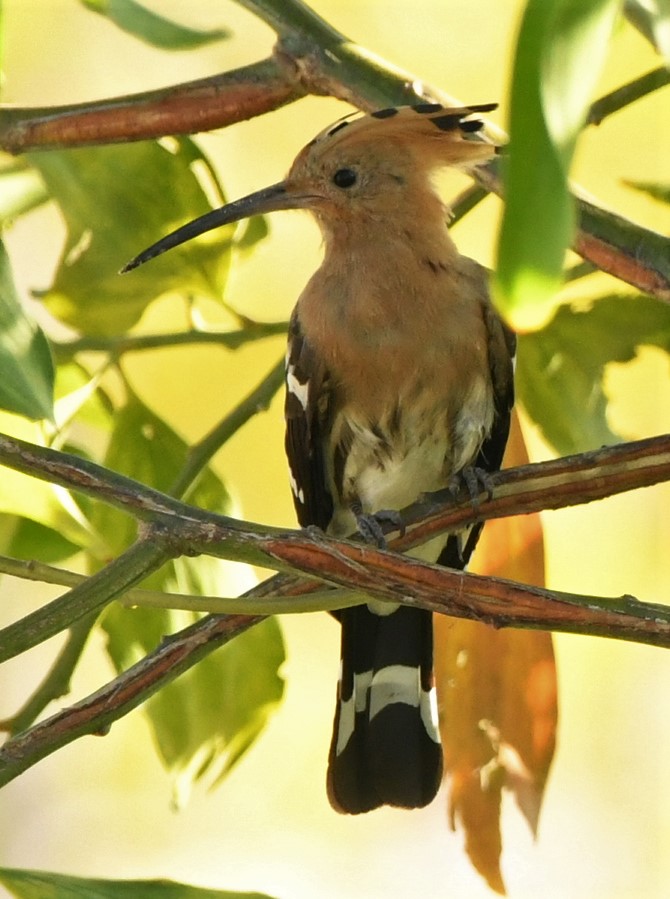
- Asian Green Bee-eater (Merops orientalis) 8 (ad, imm); most without elongated central tail feathers; gregarious, sallying from low perches in trees and shrubs into open areas, CS (C).
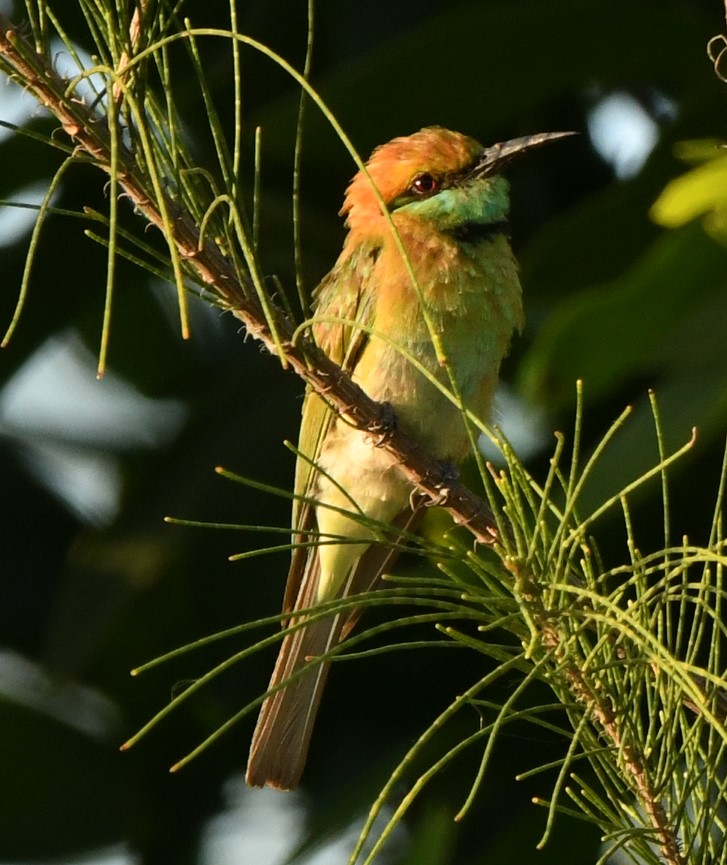
- Blue-throated Bee-eater (Merops viridis) 2 individuals sallying from top of tall trees, CS (C).
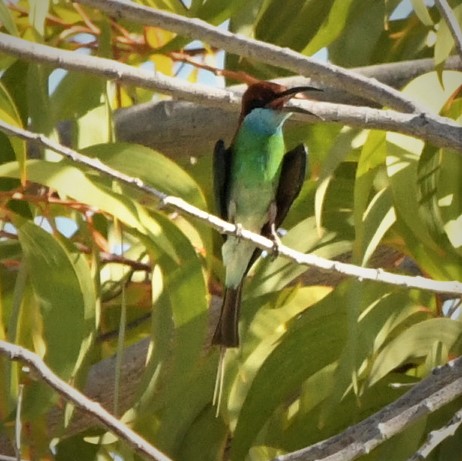
- Chestnut-headed Bee-eater (Merops leschenaulti) 1 flying over open area, CS (R).
- White-breasted Kingfisher (Halcyon smyrnensis) 4 wary, readily flushed from trees next to ponds, CS (C).
- Budgerigar (Melospsittacus undulatus) 2 gregarious, vocal in a hedgerow of eucalyptus on n border, G, AR, (R- an Australian exotic).
- Bar-winged Flycatcher-shrike (Hemipus picatus) in clumps of roadside trees, CS (R).
- Common Iora (Aegithina tiphia) 2 gregarious, pairs in clumps of roadside trees, CS (C).
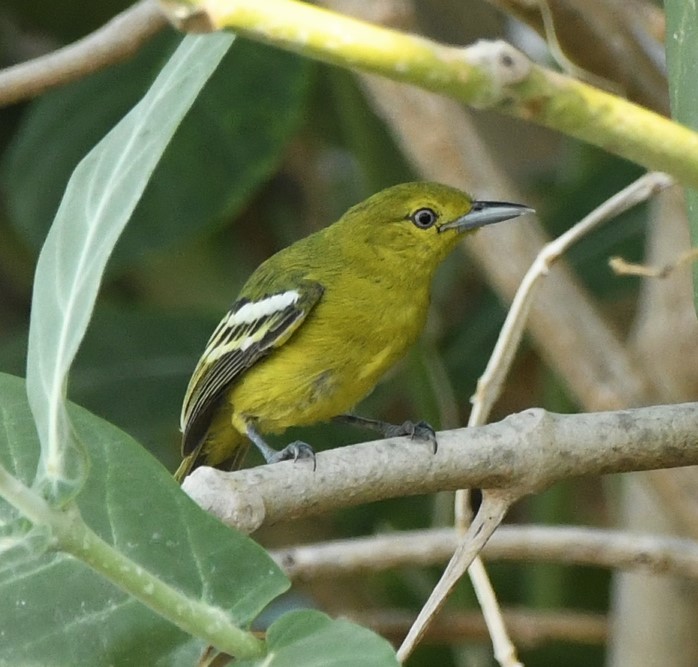
- Black Drongo (Dicrurus macrocercus) 5 vocal, gregarious, often calling from tree-tops, CS (C).

- Burmese Shrike (Lanius collurioides) 2 individials in large shrubs and small trees, vocal (scold calls as I approached, nest?) CS (C).
- Indochinese Bushlark (Mirafra erythrocephala) 6 (ad, imm) gregarious, often flushed from the ground, on lawns and in open, sandy areas, loosely associated with PAPI, AR, CS (C).
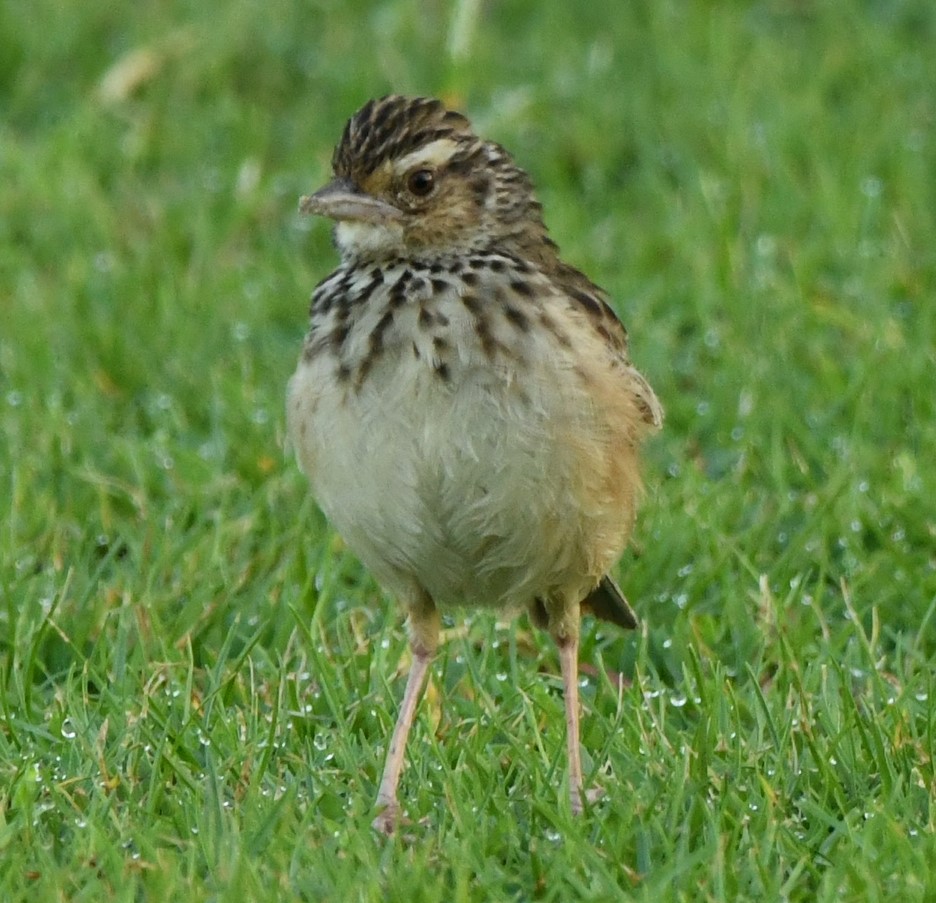
- Plain Prinia (Prinia inornata) 6 vocal, gregaious, pairs active in roadside shrubs and small trees, often near ponds, CS (C).
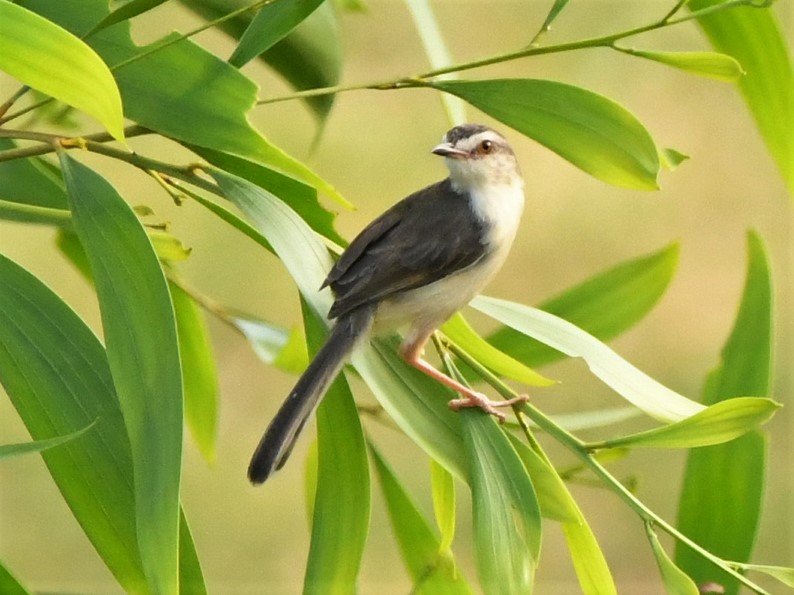
- Common Tailorbird (Orthotomus sutorius) 6 individuals and pairs in shrubs and small trees, vocal, AR, CS (C).
- House Swallow (Hirundo javanica) 2 flying low over wetlands, CS (R).
- Eurasian Barn Swallow (Hirundo rustica) 1 flying over ponds, CS (R).
- Streak-eared Bulbul (Pycnonotus conradi) 10 gregarious, vocal, utilizing a wide variety of vegetation for cover and foraging, AR, CS (C).
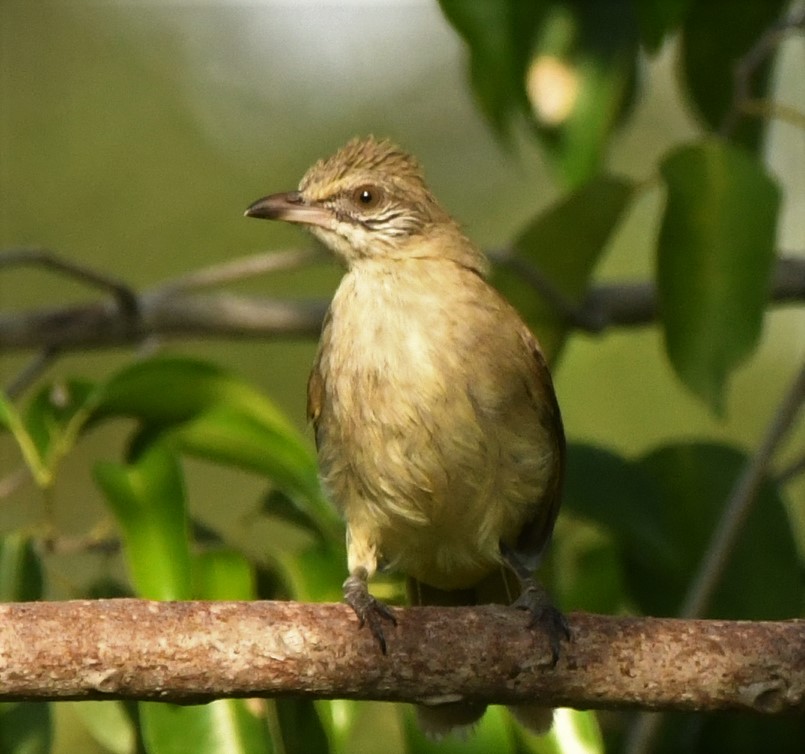
- Common Myna (Acridotheres tristis) 2 in trees an on lawn, AR (R).
- Purple Sunbird (Cinnyris asiaticus) 1 (m – eclipse plmg.) in flowering ornamental shrubs, G, AR (UC).
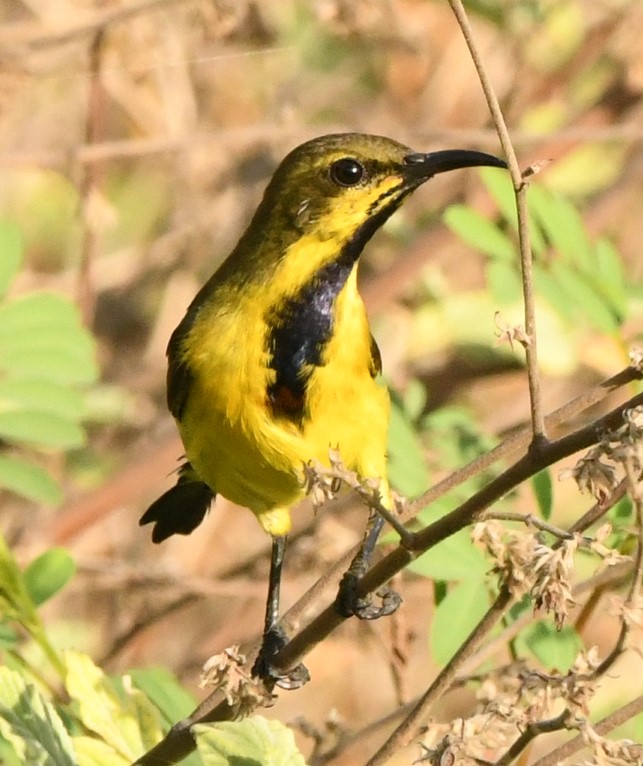
- Ornate Sunbird (Cinnyris jugularis ornatus) 4 in flowering shrubs, vines and trees, G, AR, CS (C).
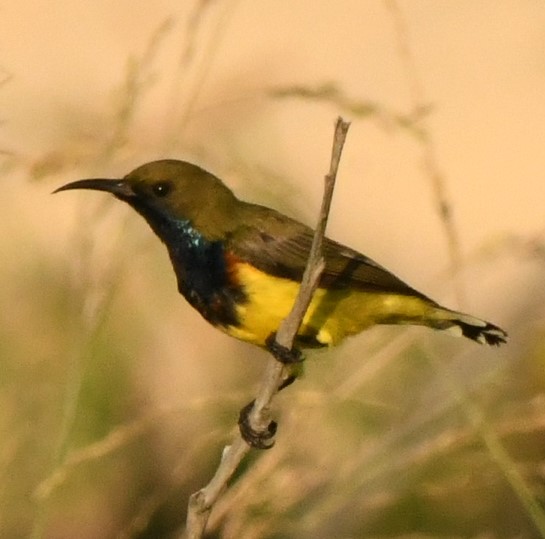
- Scaly-breasted Munia (Lonchura nisoria) 6 (ad, imm) gregarious on ground and in shrubs, AR, CS (C).
- Indian Sparrow (Passer indicus) 12 (m,f) gregarious on lawns and bare ground, keeping apart from EUTS, G AR (C).
- Plain-backed Sparrow (Passer flavoleus) 2 (m,f) pairs in small roadside trees near ponds, CS (C).
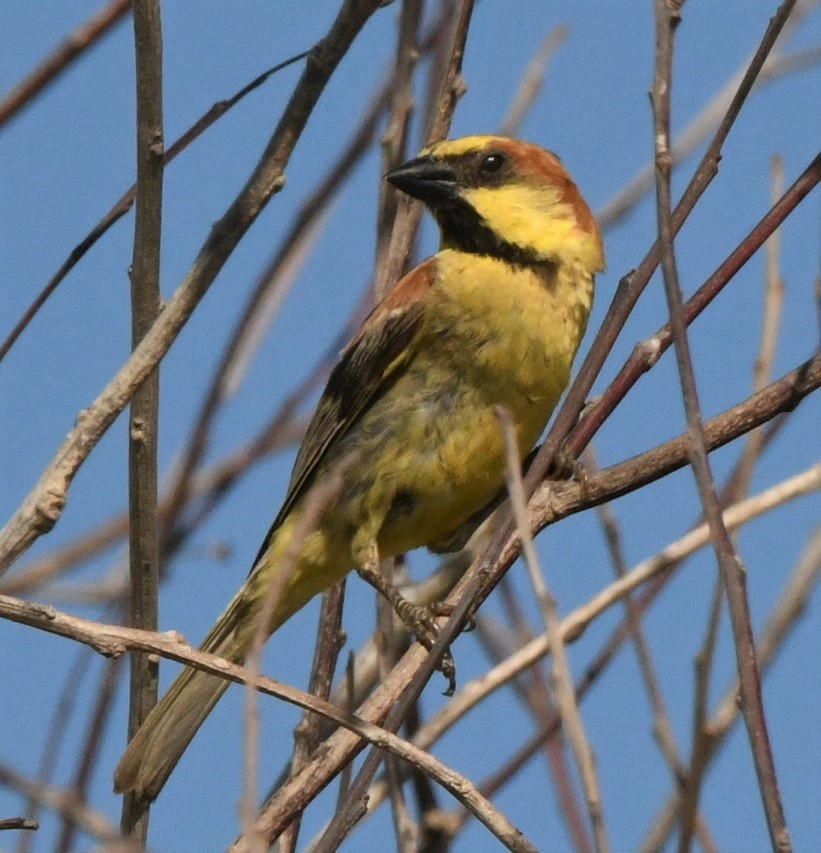
- Eurasian Tree Sparrow (Passer montanus) 40 (m,f) gregarious on lawns and in gardens, G, AR (C).
- Paddyfield Pipit (Anthus rufulus) 14 ubiquitous on lawns and in open areas, G, AR, CS (C).
